
About UsThe Numismatic Bibliomania Society is a non-profit organization devoted to the study and enjoyment of numismatic literature. For more information please see our web site at coinbooks.org SubscriptionsThose wishing to become new E-Sylum subscribers (or wishing to Unsubscribe) can go to the following web page link MembershipThere is a membership application available on the web site Membership Application To join, print the application and return it with your check to the address printed on the application. Membership is only $20 to addresses in the U.S., $25 for First Class mail, and $30 elsewhere. For those without web access, write to: David M. Sundman, Treasurer
AsylumFor Asylum mailing address changes and other membership questions, contact David at this email address: dsundman@LittletonCoin.com SubmissionsTo submit items for publication in The E-Sylum, just Reply to this message, or write to the Editor at this address: whomren@gmail.com BUY THE BOOK BEFORE THE COINSale Calendar |
- WAYNE'S WORDS: THE E-SYLUM JULY 12, 2015
- NBS EVENTS AT THE 2015 ANA CONVENTION
- KOLBE & FANNING ONLINE SALE CLOSES JULY 25, 2015
- NEW BOOK: HALF CENTS AND LARGE CENTS
- NEW BOOK: EARLY UNITED STATES HALF DOLLARS
- NEW BOOK: MONNAIES FRANÇAISES 1789-2015
- NEW BOOK: THE COINS OF THE LOW COUNTRIES
- NEW BOOK: MEDAL PORTRAITS: THE SPECTACLE OF BRONZE
- NEW BOOK: APPRAISING YOUR COIN COLLECTION
- BOOK REVIEW: THE DENARIUS
- EL SITIO NO. 15 PUBLISHED
- A NUMISMATIC BOOK IN THE HANDS OF ISIS FIGHTERS
- NOTES FROM E-SYLUM READERS: JULY 12, 2015
- SOME COIN TERMS OF THE 1840S AND 1850S
- DOROTHY FAXON, WAYTE RAYMOND'S ILLUSTRATOR
- RALPH ANDREWS BARRY AND 'WITH THE COIN COLLECTOR'
- BOOK PREVIEW: LINCOLN'S METALLIC IMAGERY
- NUMISMATIC MISCELLANY: JULY 12, 2015
- A VISIT TO YALE’S COIN AND MEDAL COLLECTION
- GEORGE MINOT 1934 NOBEL PRIZE MEDAL OFFERED
- QUERY: WAS THE THREE HOURS FOR LUNCH CLUB MEDAL STRUCK?
- SCULPTOR AND MEDALLIST R. TAIT MCKENZIE
- CANADA'S NEW POLAR MEDAL
- QUERY: BRAZILIAN 960 REIS HOST COIN IDENTIFICATION
- U.S. MINT FILLS POSITIONS WITH FEMALES, VETERANS
- RHETT JEPPSON NOMINATED FOR U.S. MINT DIRECTOR
- NUMISMATICS IN THE PICTURE OF DORIAN GRAY
- OLD-TIME COLLECTORS AND THEIR OLD-TIME COLLECTIONS
- MILLENNIALS NIX THEIR PARENTS’ TREASURES
- THE FUTURE OF THE NUMISMATIC HOBBY
- ROSENBLUM 2015 SUMMER AUCTION 45A HIGHLIGHTS
- THE COIN OF THE FUTURE
- READER RED BOOK RAMBLINGS
- HAMMERED SILVER HALFPENNY OF EDWARD I FOUND
- MORE ON THE BRISTOL OLD VIC 'GOLDEN TICKET' TOKEN
- HOW MANY FACES OF WOMEN ARE THERE ON BANKNOTES?
- TREASURY STANDS BY PLAN TO REPLACE HAMILTON PORTRAIT
- NEW SYRIAN BANKNOTE DROPS ASSAD PORTRAIT
- UPSIDE-DOWN MAO WATERMARK ERROR BANKNOTE
- HARVEY STACK ON THE PRINTED WORD IN NUMISMATICS
- CASE STUDY: NUMISMATIC LITERATURE IN THE HUMANITIES
- FEATURED WEB PAGE: COINS IN MOVIES
Click here to access the complete archive
To comment or submit articles, reply to whomren@gmail.com
WAYNE'S WORDS: THE E-SYLUM JULY 12, 2015

New subscribers this week include: Dr. Gregory V. Dubay, courtesy of John and Nancy Wilson, Bill Seldon, courtesy of Bob Fritsch, and John Okerson. Welcome aboard! We now have 1,850 subscribers.
This week we open with NBS events at the upcoming ANA convention, a reminder about Kolbe & Fanning's upcoming online sale, six new numismatic books, and one review.
Other topics include numismatic literature in the hands of ISIS, common coin terms of the 1840s and 1850s, the Yale coin and medal collection, Canada's Polar medal, coins of the Low Countries, the fippenny bit and the York shilling.
To learn more about upside-down Mao, Bergrechnungsmarke, coins of Domitianus, convict love tokens, Dorothy Faxon, Ralph Andrews Barry, R. Tait McKenzie, Adventures In Hoboken, and the Three Hours For Lunch Club medal, read on. Have a great week, everyone!
Wayne Homren
Editor, The E-Sylum
NBS EVENTS AT THE 2015 ANA CONVENTION
Thurs., August 13, 11:30 am to 1:00 pm, NBS Symposium, Room 22
Thurs., August 13, 1:00 to 2:30 pm, NBS Board Meeting, Room 24
Friday, August 14, 11:30 am to 1:00 pm, NBS General Meeting, Room 5
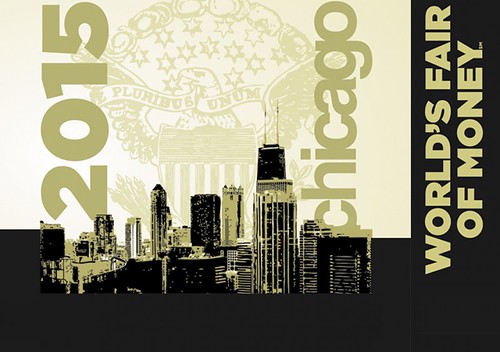
To view the complete convention schedule of events, see:
/www.money.org/worldsfairofmoney/schedule
Marc adds:
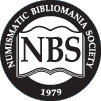 The Board Meeting is open to the public, and NBS members are welcome to attend and contribute their ideas and perspective on our
organization. The General Meeting will feature our annual Numismatic Literature Auction, featuring several rarities and interesting works for
reasonable prices.
The Board Meeting is open to the public, and NBS members are welcome to attend and contribute their ideas and perspective on our
organization. The General Meeting will feature our annual Numismatic Literature Auction, featuring several rarities and interesting works for
reasonable prices.
Also, NBS is in need of a replacement for David Sundman as Treasurer. Any interested individual should contact me at mcricard@yahoo.com.
KOLBE & FANNING ONLINE SALE CLOSES JULY 25, 2015
Kolbe & Fanning Numismatic Booksellers are pleased to announce that we will be offering selections from the numismatic libraries of Margo Russell and Raymond Hale, along with other properties, in an online sale to be held Saturday, July 25.
Highlights include signed books and other memorabilia from the library of Margo Russell, editor of Coin World from 1962 to 1985. While never considering herself a numismatic scholar, Russell’s position at the center of the hobby and her personal charm meant that many authors sent her inscribed copies of their books. Many such titles are included in this sale, including works rarely encountered signed by their authors.
Some selections from the libraries of Russell, Hale and other consignors include:
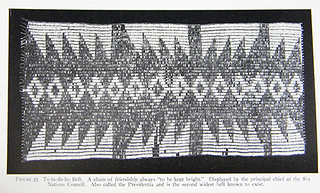
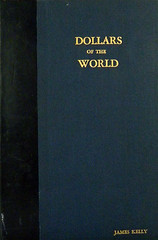
Lots 63 and 102
--Scarce works on wampum, wampum belts and other Indian trade goods, including Clarke’s monograph on The Wampum Belt Collection of the New York State Museum (lot 63).
-- James Kelly’s deluxe bound copy of Kaufman’s Dollars of the World exhibit (lot 102).
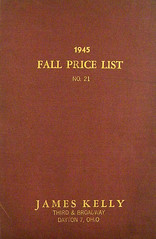
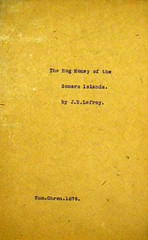
Lots 153 and 189
--A rare hardcover version of Kelly’s 1945 fixed price catalogue (lot 153).
--A rare 1876 offprint on the Somer Islands “Hog Money” (lot 189).
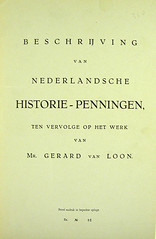
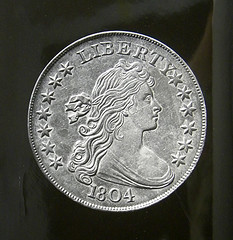
Lots 194 and 205
--A rarely seen reprint of the continuation to Van Loon (lot 194).
--A copy of the regular B. Max Mehl Dunham sale, with the extra photographic plates of the 1804 dollar bound in (lot 205).
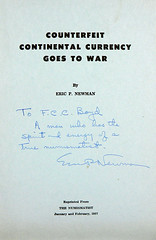
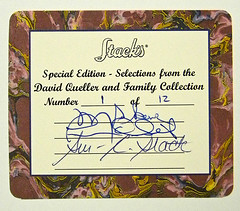
Lots 223 and 296
--A copy of Eric P. Newman on counterfeit Continentals, inscribed to F.C.C. Boyd (lot 223).
--Number 1 of only 12 limited edition copies of Stack’s 1997 Queller sale catalogue (lot 296).
The rest of the July 25 sale features a varied selection of books on ancient and foreign coins, as well as a nice offering of works on U.S. numismatics. The delicacies from these libraries are being held over for our next printed sale, which will mail soon and close on August 22.
Although billed as an “online sale,” bidders may participate in the July 25 sale in a variety of ways: regular mail, email, phone, fax or online bidding (live or absentee). Any absentee bids must be received by the day before the sale (July 24) in order to be entered. Live online bidding will commence on Saturday, July 25 at noon eastern time. See auction.numislit.com to register for the sale, browse lots and place bids. All lots are illustrated online. A PDF of the sale lots will be posted on our regular numislit.com website for ease of reference.
For more information, please contact David Fanning at df@numislit.com or see the Kolbe & Fanning website at numislit.com. We look forward to hearing from you.
NEW BOOK: HALF CENTS AND LARGE CENTS
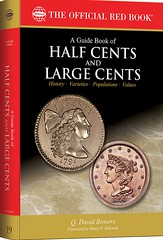 Whitman Publishing announces the release of A Guide Book of Half Cents and Large Cents, by Q. David Bowers. The 576-page book
(number 19 in the popular Bowers Series) can be ordered from booksellers and hobby shops nationwide, and online (including at www.Whitman.com), for
$39.95. It can also be borrowed for free as a benefit of membership in the American Numismatic Association, through the Dwight N. Manley Numismatic
Library.
Whitman Publishing announces the release of A Guide Book of Half Cents and Large Cents, by Q. David Bowers. The 576-page book
(number 19 in the popular Bowers Series) can be ordered from booksellers and hobby shops nationwide, and online (including at www.Whitman.com), for
$39.95. It can also be borrowed for free as a benefit of membership in the American Numismatic Association, through the Dwight N. Manley Numismatic
Library.
Copper half cents and large-size one-cent coins were the early pocket change of the United States. “Thanks to their variable toning, and differing levels of craftsmanship by the Philadelphia Mint’s engravers, there are hundreds of enjoyable varieties for collectors,” Bowers says.
These popular copper coins were made from 1793 (the year after the Philadelphia Mint was founded) into the late 1850s, shortly before the Civil War started. In the Guide Book of Half Cents and Large Cents they are given the famous Q. David Bowers treatment: insightful die-by-die study of 832 varieties, rich historical background, and detailed data analysis. The text is illustrated with more than 1,600 images. Bowers—the “Dean of American Numismatics” and the most prolific numismatic author of all time—tells collectors how to evaluate quality, determine value, understand the market, and make smart purchases.
Bowers provides a wealth of information including mintages, existing populations, grading standards, values in up to 11 grades, auction records, and keys to collecting. Historical background sets the coins in the broader context of American life from the 1790s through the 1850s, showing how war and other national events affected the coins’ designs and production.
The Guide Book of Half Cents and Large Cents includes a history of the first and second Philadelphia mints; biographies of important Mint figures of the 1790s through the 1850s; a history of half and large cent collecting, including biographies of many important 20th-century collectors; and strategies for building a significant collection.
Numismatic researcher Harry E. Salyards says, “I believe that this book will become the first work in the field of American numismatics since Sheldon’s Penny Whimsy to be dipped into, time and time again, not just for the technical details on some particular coin, but for sheer reading pleasure.”
A Guide Book of Half Cents and Large Cents
By Q. David Bowers; foreword by Harry E. Salyards
ISBN 079484316-8
6 x 9 inches, softcover
576 pages
full color
Retail $39.95 U.S.
For more information, or to order, see:
A Guide Book of
Half Cents and Large Cents, 1st Edition
(www.whitman.com/store/Inventory/Detail/A-Guide-Book-of-Half-Cents-and-Large-Cents-1st-Edition+0794843166)
THE BOOK BAZARRE
NEW BOOK: EARLY UNITED STATES HALF DOLLARS
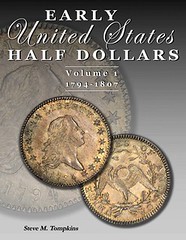 Early United States Half Dollars, Volume I 1794-1807
Early United States Half Dollars, Volume I 1794-1807
By Steven M. Tompkins
In this exciting new hardbound work, proudly printed and bound in the U.S.A., you will find over 500 pages covering each known die marriage for the years 1794-1807. This is surrounded by sections covering design, manufacture, new theories, and explanations for why certain things were done, based on Mint documentation and evidence found on the coins themselves. Included are quick finding charts and pictorial identifiers for each year; detailed listings of die stages; as well as, oversized color photos of every die marriage. New updated rarity ratings are included, as well as a pictorial condition census with pedigrees for all R-6 to R-8 rated die marriages.
Every die marriage is now listed in emission sequence (the order they were struck in) and therefore a new numbering system was needed and was incorporated, with a handy conversion chart in both the front and back of the book for ease in transition from the older designations.
The appendices contain interesting information on among other things, patterns, die trials, private re-strikes, error coins, counterstamps, etc., along with many useful charts, die re-marriage listings, master die/hub listings, reproductions of original Mint documents and much, much more! This is the first volume of several that will cover the entire lettered edge half dollar series from 1794 through 1836.
The pre-order price for one copy is $79.00 delivered. This price is only good for a limited time (see below). Copies can be ordered by either sending payment to:
Steve M. Tompkins
P.O. Box 844
Peculiar, MO 64078
Or you can go to my web site www.earlyunitedstatescoins.com and send payment via secured checkout from a PayPal account.
Orders will be filled as soon as the finished books are received from the printer, currently this should be the first week in August.
Order yours now before the price goes up! (The regular cover price is $89 plus shipping after August 5th...)
NEW BOOK: MONNAIES FRANÇAISES 1789-2015
 22nd Edition of Gadoury’s Monnaies Françaises
22nd Edition of Gadoury’s Monnaies Françaises
There are some books collectors can’t imagine to do without. Gadoury Rouge is one of those, dealing with French coins struck between 1789 and 2015. Its 22nd edition was completely revised and significantly enlarged. It now contains more than 100 new pages, yet for the same price.
Every collector of French coins knows the Gadoury Rouge. On 560 pages, it contains a complete price guide for all French coinages made between 1789 and 2015, covering areas like Monaco, Corsica and the Saarland as well.
The book’s great forte are its clarity, it lavish illustrations and the fact that many specialists are volunteering for working on particular areas of expertise, to present a catalog that is based on state-of-the-art research.
Every new edition, therefore, contains much more than a ‘mere’ price adjustment to current market conditions.
The 22nd edition was completely revised as regards the following subjects:
- Coins prior to the introduction of the franc in 1795
- Newly added: Coinages of Napoleon in Italy, with a great number of hitherto unedited variants
- French commemorative coins between 1989 and 2001
- French euro gold and silver commemorative coins struck between 2001 and 2015, including all mintages
- Coins from Monaco: introduction of a completely new typology of the sol de billon of Antonio I
Other news of this edition:
- More than 500 additional photos with many close-up details
- More than 100 additional pages
- Entirely new numbering of French commemorative coins after 1989
- Entirely new numbering of Monegasque coins
What remains unaltered is the price. For only 29 euros the extensive standard work on French coinage, spanning 560 pages, is obtainable from www.gadoury.com or Editions V. Gadoury. Le Panorama. 57, rue Grimaldi, 98000 Monaco. phone: 00377 93 25 12 96, e-Mail: contact@gadoury.com
Please note: The book will be delivered to Europe and Overseas per FEDEX.
Monnaies françaises 1789-2015. Éditions Victor Gadoury, Monaco, 2015. 22nd edition. 567 pages with full colour illustrations throughout. Hardcover, 15 x 20.7 cm. ISBN: 2-906602-41-8. 29 euros.
NEW BOOK: THE COINS OF THE LOW COUNTRIES
THE COINS OF THE BURGUNDIAN, SPANISH AND AUSTRIAN LOW COUNTRIES, AND OF THE FRENCH AND DUTCH PERIODS (1434-1830)
by Hugo VANHOUDT
 This book provides an overview of the centralized coinage in the Low Countries from 1434 to 1830. The first year is based on the Ordinance
of January 23, 1434, whereby Philip the Good introduced a uniform coinage in his territories – the latter year coincides with the end of the common
coinage under William I, King of the United Netherlands, due to the proclamation of the independence of Belgium in 1830.
This book provides an overview of the centralized coinage in the Low Countries from 1434 to 1830. The first year is based on the Ordinance
of January 23, 1434, whereby Philip the Good introduced a uniform coinage in his territories – the latter year coincides with the end of the common
coinage under William I, King of the United Netherlands, due to the proclamation of the independence of Belgium in 1830.
This book includes all the official emissions made by the reigning monarch, the obsidional coins in this period, and the other special emissions such as piedforts, presentation coins, etc.
664 pages with some 2000 pictures in colour – bound – supplement with price estimations
Nederlands – Français – English
ISBN 978-90-802-8784-3
price: 70 euro (+ p&p)
Available from the author:
vanhoudt.hugo@gmail.com
This book seeks to complement and update the seminal work Les monnaies des Pays-Bas bourguignons et espagnols by H. Enno Van Gelder & Marcel Hoc (Amsterdam, 1960). It provides an overview of the centralized coinage in the Low Countries, from 1434 to 1830. The first year is based on the Ordinance of January 23, 1434, whereby Philip the Good organized a uniform coinage in his territories — the latter year coincides with the end of the common coinage under Wlliam I, King of the United Netherlands, due to the proclamation of the independence of Belgium in 1830.
Administratively, Philip the Good’s territory was larger than the territory of the current Netherlands and Belgium combined. Since the souvereign usually stayed in Flanders or Brabant, they spoke of ‘countries hither about’ or ‘ 'les pays de par deça, being the surrounding and adjacent areas, and the ‘countries thither about’ or ‘les pays de par dela, being the Burgundian territories in France.
The coinage in the Low Countries is described here in the broadest sense with regard to the administrative territory (including Burgundy), and includes all the official emissions made by the reigning monarch, the obsidional coins in this period, and other special emissions such as piedforts, presentation coins, etc. The aim is to combine as much information as possible in this work. Additions and corrections to this book will be available at www.hugovanhoudt.be.
This book is the result of years of effort and could not have been brought to a good end without the help of many people who have assisted me in several ways, even small, by letting me visit their collection, by providing me information and illustrations, etc.
My most sincere thanks go to the many numismatists, collectors and public institutions which have helped me, and especially to Mr. Jan Moens, who has displayed an inexhaustible energy in attacking the many layout tasks I have given to him; without him, this book would never have been published.
I also like to make a special mention to Mr. Willem Van Den Nieuwenhof and and John Sanders, who were involved in the complete catalog, to Mr. Alain Fossion (French) and Robert Levinson (English), who took the foreign-language texts on their behalf, and to Mr. Bert Van Beek and Ronald Wientjes, who were mainly involved with the complex Burgundian period.
Hugo Vanhoudt Heverlee, March 1st, 2015
ROSENBLUM AUCTION ACTION
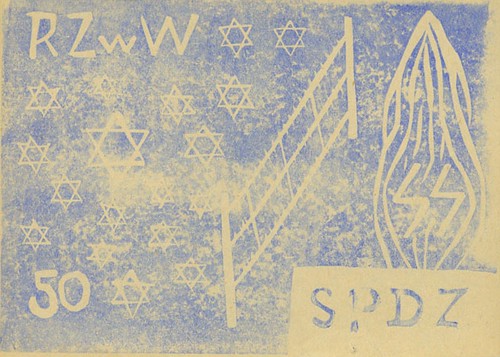
Lot 289: Poland Warsaw Ghetto. 50 Groszy
Our Summer 2014 auction 45A featuring the "Philadelphia Collection" Part Two is now online, with a closing date of July 16, 2015. Please click on the link to the auction here .
NEW BOOK: MEDAL PORTRAITS: THE SPECTACLE OF BRONZE
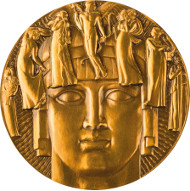
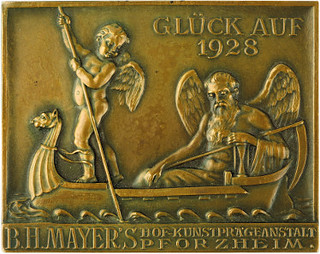
Rafael Masó was one of the most important Catalan architects of the fin de siècle. The house in Girona where he was born and has lived for many years has become a museum. Until 12 September 2015 the Casa Masó shows medals from the Masó collections.
Casa Masó ‘Medal Portraits: The Spectacle of Bronze’ displays six sections containing nearly four hundred pieces, made during the period of Masó’s life by over one hundred and sixty medallists from some twenty different countries.
The exhibition catalogue reproduces a selection of medals showing the importance of the portrait during those thrilling, albeit convulsive fifty years.
The Casa Masó collection is a constant source of surprises and wonders that under the management of the Rafael Masó Foundation is becoming material for study and knowledge on the heritage and history of the city of Girona.
The cataloguing and study of two medals belonging to Casa Masó brought the museum in contact with Rossend Casanova, art historian, collector and specialist in modern numismatics, who not only helped to establish the value and interest of the pieces, but also suggested that they should be exhibited within the context of the life of Rafael Masó, from 1880 to 1935. Rossend Casanova curated the medal exhibition and was its main lender.
Exhibition catalogue:
Rossend Casanova, ed. Medal Portraits: The Spectacle of Bronze. Girona: Úrsula / Fundació Rafael Masó, 2015. Catalan-English
edition, 192 pages, 14 €.
For more information, or to order, contact Casa Masó directly via email:
info@rafaelmaso.org
To read the complete article, see:
Medal Portraits exhibition in Spain (http://coinsweekly.com/en/News/4?&id=3529)
NEW BOOK: APPRAISING YOUR COIN COLLECTION
I just finished a book called Appraising Your Coin Collection. I was using this for a class I was teaching at a local college to 50+ year olds.
Basic concept of the book was to understand what your coins are worth, especially if you inherit or given them.
The second half of the book goes into most of the series, listing the rare dates and die varieties.
You can view this book at www.coinzip.com/appraising-your-coin-collection.php
You can download the book by scrolling to the bottom, hovering your mouse over the bottom right, symbols will appear, click on the one that looks like a disk.
Thanks to Alan at CoinZip for help putting this together online and making it available to collectors.
The nice thing about a virtual book also is that it can be updated. If you have suggestions, please email me at kevinjflynn88@yahoo.com
BOOK REVIEW: THE DENARIUS
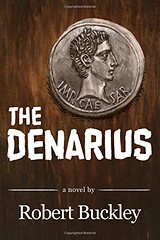 Robert Buckley has just released his latest book, The Denarius, and if you are looking for a fine read, this is it. A denarius is a
silver coin which originated in Rome in Biblical times and went with the Romans wherever they traveled.
Robert Buckley has just released his latest book, The Denarius, and if you are looking for a fine read, this is it. A denarius is a
silver coin which originated in Rome in Biblical times and went with the Romans wherever they traveled.
About two years ago, we interviewed Buckley about his hiking experiences: on the Appalachian Trail, and in England, Ireland, Scotland and Wales. During one of the hiking journeys to Great Britain, he heard that farmers sometimes allow groups of foreigners, headed by reputable British guides, to take metal detectors and explore their fields. These excursions occur in the spring before planting and in the fall after the crops are harvested.
When we interviewed Buckley for Two Miles an Hour, in late August 2013, he was planning just such a trip. As he researched about the treasures a person might find, he learned that as Nigel, the guide in The Denarius put it, "There's been people living and warring and dying around here for over 2000 years."
Indeed, in Norfolk County where part of the story takes place, Celts, Romans, Picts, Vikings and Saxons plus other groups had fought, plundered and left items. Old coins, in particular, were among the treasures those with metal detectors hoped to recover. One of the coins Buckley learned about was a Roman one made of silver and called a denarius; hence, the title of the book.
The beginning of the book starts not in Great Britain, but in Milan during Biblical times. Buckley includes information and tales about the coin striker Severus and his role in the creation of a special silver denarius created in honor of the emperor Caesar August. From there, a number of people, including Jesus, hold that coin at one point or another.
Buckley provides excellent historical background about the way of things in Milan and Rome as well as in England and near the North Sea where Roman soldiers built garrisons and fought the local tribes. He seamlessly shows us the path of the denarius.
The story then skips ahead to modern times and a restauranteur named Larry Watkins who lives in Milwaukee, Wisconsin. Larry had joined a club for people interested in metal detecting. At one of the meetings, a speaker told of guided tours to hunt in England and showed some of the coins, pieces of jewelry, etc., that he had found on such a tour. Larry was instantly attracted to that kind of adventure and signed up for one.
Despite the vast coverage in years and geography, Buckley has a gift for helping us see the connections and the history. He has been to both Rome and England and gives us necessary background information.
And as he puts it, "My characters are regular people. They make mistakes; they do good things." He writes with clarity and an ease that helps us understand the various situations, feel concern when there is a reason to do so, and enjoy the fun events and conversations.
If you would like to buy The Denarius, you can contact Buckley by email at repb35@gmail.com and receive an autographed edition. The cost of the softback book is $15. It can be purchased from Amazon.com in both print (postage additional) and ebook formats. It is also available for sale at the bookstore Next Page in the New Bo area of Cedar Rapids.
To read the complete article, see:
Marion author Buckley completes fourth book
(www.mariontoday.org/times/article.php?id=4306)
From Amazon:
Rome, Italy. A new coin, a handsome silver denarius, is struck during the reign of the Emperor Caesar Augustus. The year is A.D. 8. Fated for an amazing journey, the coin changes multiple hands as it travels from Imperial Rome to ancient Jerusalem where it plays a key part in a life changing event. Following the rule of the mad Emperor Nero, the denarius travels with a Roman soldier to the outposts of northern Britain where it is eventually lost during battle. For over 2000 years the coin remains buried in the rural English countryside until it again sees the light of day when it is dug up by a terminally ill treasure hunter from Milwaukee, WI. Strangely, the coin appears undamaged by the ravages of time. Thus continues a puzzling series of events as the mysterious coin touches and changes the lives of not only the dying treasure hunter, but an alcoholic Catholic priest, a Mayo Clinic researcher and an abandoned Chippewa Indian girl.
For more information, or to purchase, see:
The
Denarius
(http://www.amazon.com/Denarius-Robert-Buckley/dp/0692344993/ref=sr_1_1?s=books&ie=UTF8&qid=1436631917&sr=1-1&keywords=The+Denarius)
EL SITIO NO. 15 PUBLISHED
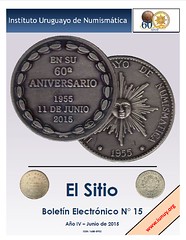 “El Sitio” N° 15 contains, in its 24 pages, an article on numismatic tokens, the chronicle of the 60th anniversary celebrations of the
Instituto Uruguayo de Numismática (IUN), information from different events and gatherings and also a long editorial written by the president of the
IUN, Horacio Morero, who has been director of the institution for eight years, this being his second term of four years, and is leaving that place of
honour with the new elections to be held next August 2015.
“El Sitio” N° 15 contains, in its 24 pages, an article on numismatic tokens, the chronicle of the 60th anniversary celebrations of the
Instituto Uruguayo de Numismática (IUN), information from different events and gatherings and also a long editorial written by the president of the
IUN, Horacio Morero, who has been director of the institution for eight years, this being his second term of four years, and is leaving that place of
honour with the new elections to be held next August 2015.
The cover of “El Sitio” N° 15 shows the pictures of the medal from the 60th Anniversary that was minted in the Tammaro house in Uruguay in three metal versions: copper, plated copper and silver.
The numismatic article, written by Horacio Morero Ferrero, is related to the shearing tokens of the “Martín Chico” Ranch, a historical “estancia” in the Colonia Department, in the west of Uruguay. “Martín Chico” was a Ranch belonging to the Bell family, immigrant from Scotland that came with other Scottish people to Uruguay in the XIX century.
Among other relevant information contained in “El Sitio” to highlight to numismatic colleagues, friends and followers it is relevant to mention: a reference note from a new numismatic book written by Hugo Mancebo Decaux “El exilio de Agustín Jouve y su familia en la ciudad de Yaguarón 1848-1857”; the creation of a new social activity in the IUN called “El lunes de los socios”; a disertacion about Casino tokens by Nicolás Santerini; the bonds issued in the “Jornada Uruguaya de Numismatica 2014”; and information about a Uruguayan Central Bank project to issue in 2016 a new coin to commemorate the 200 years of the foundation of the National Library (Biblioteca Nacional).
To read the complete issue, see:
http://www.iunuy.org/designroom00/wp-content/uploads/2014/03/ElSitioN%C2%BA15a.pdf

A NUMISMATIC BOOK IN THE HANDS OF ISIS FIGHTERS
In preparing a session on cultural property issues for the Eric P. Newman Graduate Seminar, I was reading more of the news about the systematical looting of Syria.
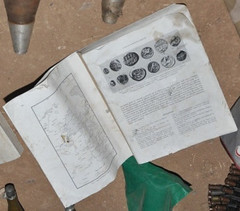 What I had missed until I read Sam Hardy’s blog on conflict antiquities is the discovery of a numismatic book among an unlikely assortment
of weapons and somehow academic-looking publications. The photograph below was one taken of materials confiscated by the Kurdish People’s Defence
Unit after a battle with Turkish Islamic State fighters.
What I had missed until I read Sam Hardy’s blog on conflict antiquities is the discovery of a numismatic book among an unlikely assortment
of weapons and somehow academic-looking publications. The photograph below was one taken of materials confiscated by the Kurdish People’s Defence
Unit after a battle with Turkish Islamic State fighters.
An open page shows what numismatists and archaeologists identified immediately as a group of various Persian and Phoenician coins, with some text below. I knew right away that I had seen this page some time in the past, and after a few minutes I was able to decipher the title of the article, ”La Syrie sous la domination achéménide” by Maurice Sartre. A Google search quickly confirmed that this was published in the volume Archéologie et Histoire de la Syrie II, edited by Winfried Orthmann and Jean-Marie Dentzer and published in 1989.
Towards the end of the book, there is a map of archaeological sites of Hawran, an area in southwestern Syria
The confiscated book is missing the first pages, its dark-green hard cover, and very last page (p. 591). The page with the text and images of coins in the Syrian photograph is page 17. Incidentally, the first volume of Archéologie et Histoire de la Syrie was published in 2013.
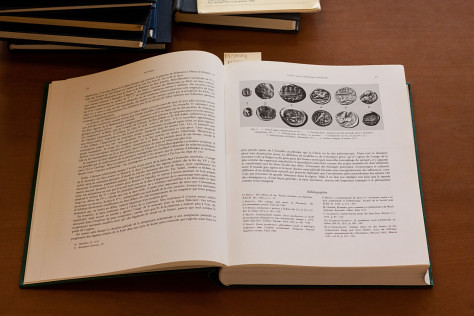
ANS Library copy
Now how this very scholarly book on archaeology of Syria ends up in the hands of ISIS fighters is an interesting question. I, for one, have never underestimated the often erudite knowledge people who are involved in looting ancient sites in the Mediterranean. For people interested in a general overview of coins from Syria, this book is indeed helpful. Articles by Christian Augé on “La monnaie en Syrie à l’époque hellénistique et romaine” (pp. 149–190, with four plates illustrating 71 coins) and by Cécile Morrisson (who won the ANS Huntington Medal in 1995) on “La monnaie en Syrie byzantine” provide excellent and well-illustrated introductions to the coins of this region. Her article gives a considerable amount of detailed scholarly information on site finds of coins in Syria.
So this is an extremely unlikely find—a scholarly, not exactly inexpensive, and heavy—book on the archaeology of Syria in the hands of ISIS fighters. If anyone doubts the multifaceted connections between looted antiquities and war in Syria, this discovery has to make one wonder.
To read the complete article, see:
ISIS, NUMISMATICS, AND CONFLICT ANTIQUITIES
(www.anspocketchange.org/isis-numismatics-and-conflict-antiquities/)
NOTES FROM E-SYLUM READERS: JULY 12, 2015
Query: Auctori Connec and Other Emissions
David Fanning writes:
I am going to write on the 1959 Hartford Numismatic Society publication "Auctori Connec and Other Emissions" for a future installment of my column in the Numismatic Bibliomania Society's journal The Asylum. This publication is rarely offered, despite a stated printing of 200 copies. I'd like to hear from anyone who owns a copy and in particular I'd like to know which number you own (all copies are hand-numbered on the Preface page). Reply privately to me at df@numislit.com if you wish. Thanks, and I look forward to hearing from you.
C.H.V. Sutherland, Keeper of the Coin Room
Jeff Reichenberger writes:
THANK YOU to "The Numismatourist", Howard Berlin, for taking us through the Heberden Coin Room of the Ashmolean Museum of Oxford University. I have recently had occasion to research and write about C.H.V. Sutherland for an article in the Asylum. Sutherland was "keeper of the coin room" from 1957 to 1975 and its most dedicated administrator, as the coin room thrived under his direction. My curiosity about the Ashmolean and its 400+ year history was piqued during my research and Howard's 'E-Sylum tour' was the next best thing to being there.
To read the earlier E-Sylum article, see:
HOWARD BERLIN VISITS OXFORD'S ASHMOLEAN MUSEUM
(www.coinbooks.org/esylum_v18n27a09.html)
What are Bergrechnungsmarke?
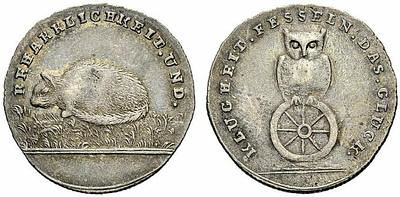
David Pickup writes:
Would any of our readers know what the German word Bergrechnungsmarke means or have heard of a catalogue called Elbesh? This is the only web picture I could find of it. It is an interesting looking piece but I have no idea what it is!
The Rocky Mountain News
Regarding my Rocky Mountain News comment on David Pickup's "Colorado's Champion" token, Tom DeLorey writes:
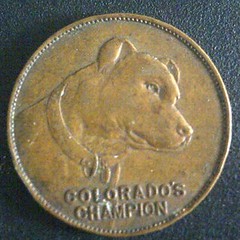 Alas, The Rocky Mountain News WAS a newspaper from Denver, though they also distributed throughout most of the state. I subscribed
to it when I lived in Colorado Springs in the early 1980's.
Alas, The Rocky Mountain News WAS a newspaper from Denver, though they also distributed throughout most of the state. I subscribed
to it when I lived in Colorado Springs in the early 1980's.
They were a Progressive paper in the days when their chief competitor, the Denver Post, was a bit more conservative. The token may have signified that they had beaten the Post in net circulation, perhaps.
To read the earlier E-Sylum article, see:
NOTES FROM E-SYLUM READERS: JUNE 28, 2015 : Colorado's Champion: Rocky
Mountain News Token (www.coinbooks.org/esylum_v18n26a09.html)
The Three Garridebs and Counterfeit 100 Pound Notes
Ron Haller-Williams wrote:
I'm surprised that Greg Ruby is requesting images of five-pound notes!!! ... the story The Adventure of The Three Garridebs deals NOT "with a printing press and counterfeit 5 pound notes" but with a printing press and counterfeit 100 pound notes!
Greg writes:
My mention of fivers instead of the 100's was a pure brain freeze. I had just looked at pics of fivers before I emailed my note. I was hoping to be Dad's age before I had these issues... I still have not come across any photos of 100’s from the 1880’s or 1890’s.
To read the earlier E-Sylum articles, see:
1890'S BANK OF ENGLAND FIVE POUND BANKNOTE IMAGES SOUGHT
(www.coinbooks.org/esylum_v18n25a20.html)
NOTES FROM E-SYLUM READERS: JUNE 28, 2015 : The Three Garridebs Counterfeit
Notes (www.coinbooks.org/esylum_v18n26a09.html)
Let's Do The Time Warp Again!
Regarding the John Kraljevich ad in the June 28th, 2015 E-Sylum, Brad Karoleff writes:
I always thought that John had a much better grasp of the workings of the Gregorian Calendar. But then, maybe he is using the Marmaduke calendar.....but that would still leave us 43 days short.
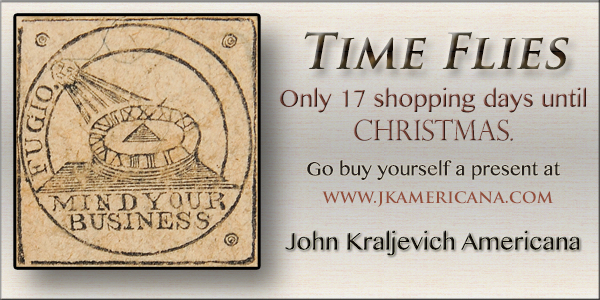
From the June 28th, 2015 E-Sylum
By the way, congratulations to John and Erik Goldstein on their honorary Doctor of Numismatics degrees from the American Numismatic Association's Florence Schook School of Numismatics. -Editor
More on the 1658 Cromwell Crown Countermark
 Howard A. Daniel III writes:
Howard A. Daniel III writes:
I believe a chop or chopmark must be from East (or South?) Asia or it is a countermark? The countermark on the 1658 Cromwell Crown is the Cross of Malta and is in a very respectful location.
To read the earlier E-Sylum article, see:
QUERY: 1658 CROMWELL CROWN CHOPMARK
(www.coinbooks.org/esylum_v18n27a08.html)
Coins of Domitianus
Regarding the coin of Domitianus described in Howard Berlin's Ashmolean article as " the only evidence pointing to the existence
of this ruler", Bob Leonard writes:
There are two coins known of Domitianus, and the first known (found in France) was doubted until this one surfaced. So Domitianus was not "formerly unknown" and where he actually ruled is unclear. The statement that he reigned for four days in 271 A.D. apparently conflates a reference to the well-known usurper Marius, recorded as ruling for only four days in 268, and Domitianus, who is tentatively dated to 271.
(You might well wonder how it was that a "formerly unknown usurper" was so well known that the length of his reign could be specified to the day. No, his coins are not dated by days. As for Marius, his coins are so common that --if his reign was as short as four days--"Marius and his entire army must have spent the whole time striking coins," as the late Robert Grossman once remarked. My own opinion is that his reign at some particular place was indeed only four days: news of the death of Laelianus was slow to arrive, but that of Marius came immediately.)
To read the earlier E-Sylum article, see:
HOWARD BERLIN VISITS OXFORD'S ASHMOLEAN MUSEUM
(www.coinbooks.org/esylum_v18n27a09.html)
Richard Picker's Museum Picks
Regarding Oxford University's Ashmoleon Museum, Alan V.Weinberg writes:
I distinctly recall that back in the 1970's renowned colonial coin dealer Richard ("Dick") Picker of Albertson L I , NY was able to obtain the finest known Date under Plowbeam New Jersey colonial cent from their collection, perhaps convincing them that one NJ copper was like any another. Dick's skills were also used rewardingly at John Hopkins Evergreen House on the Garrett colonials and large cents - then under the control of curator Carl Carlson - a few years before the collection was consigned to auction.
Asylum Back Issues Sought
Chriss Hoffman writes:
I am in search of a few back issues of The Asylum to complete my set, thought you might be able to guide me to someone that may have them.
I need only 9 issues to complete an entire set, which I'd like to have bound, I already have the first 10 volumes bound. Kolbe & Fanning, Charles Davis, and Bryce Brown already have my want list, and have not been able to help. Maybe you know some member willing to sell off some extras?
My Asylum Back Issues Want List; 10.2, 10.3, 10.4, 11.3, 12.1, 21.1, 21.2, 24.3, 24.4, whereas first number is edition, the second number is volume.
By the way, this week I ran across a similarly named publication. -Editor

The Asylum Journal was published at the Vermont Asylum for the Insane, a private institution founded in 1834 by Anna Hunt Marshall. It used a humane form of treatment on its patients, based on the theories of William Tuke that insanity was a medical condition and not due to problems of character or moral issues. This issue shows that they used the activities of editing, printing, and publishing of a weekly journal as a form of therapy for its inmates.
This particular issue is interesting and oddly relevant as various people start declaring themselves as candidates for the upcoming presidential election. In the nineteenth century it was common practice for a publication to print an election ticket for the party they supported.
To read the complete article, see:
The Asylum Journal Presents
Presidential Candidates (http://pastispresent.org/2015/good-sources/the-asylum-journal-presents-presidential-candidates/)
Correction: 1880 Morgan Dollar Varieties
The press release for Kevin Flynn's book on Morgan dollar varieties stated:
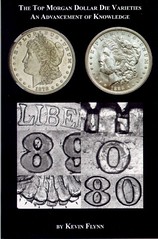 There are approximately twenty-five known 1880 Morgan Dollars; the most for any one year in any series. Letters found in the
National Archives showed the only time these overdates could have been created. Many of these 1880 Morgan overdates have diagnostics which are not
seen on other overdates and were the key to unraveling the mystery on how these overdates were created.
There are approximately twenty-five known 1880 Morgan Dollars; the most for any one year in any series. Letters found in the
National Archives showed the only time these overdates could have been created. Many of these 1880 Morgan overdates have diagnostics which are not
seen on other overdates and were the key to unraveling the mystery on how these overdates were created.
Bob Leonard writes:
I think that the words "overdate varieties of" somehow disappeared from the first sentence.
Kevin confirms this. He writes:
Bob is correct - there are about 25 known overdate varieties of 1880 Morgan dollars.
To read the earlier E-Sylum article, see:
NEW BOOK: THE TOP MORGAN DOLLAR VARIETIES
(www.coinbooks.org/esylum_v18n27a04.html)
THE BOOK BAZARRE
SOME COIN TERMS OF THE 1840S AND 1850S
The following newspaper article was written by unknown author living in 1898, reminiscing about the changes he had seen growing up 50 years earlier in Ohio, Illinois, and later New York. What is rather unique, the author chose to write about coins in circulation and the terms associated with them. Here is a firsthand account reaffirming that our Liberty Seated coinage in the 1840s and 1850s circulated hand in hand with a “good deal of foreign coins.”
March 20, 1898, Los Angeles Herald
The Coins of Former Days: Some of the terms Used in This Country to Designate Them
In Ohio, in 1844 and previously, there was a good deal of foreign coin in circulation, mostly Spanish, with some of the old state coinage of different states occasionally making its appearance. One of the most plentiful of these foreign coins was a piece which passed cur-rent for 6 ¼ cents. In Ohio this was known as a fip-penny bit, a contraction, probably, of fivepenny bit. The half dimes of American coinage were also becoming frequent at that time, and as a distinction between the half dime and the fippenny bit, the former was contracted to the word “fip.” The dime went under its lawful name, while the old Spanish double of the fip-penny bit was known as the “bit”, and the Spanish and Mexican quarter dollars were nearly always referred to as “two bits.” The latter term, I think, still obtains in reference to quarter dollar American pieces in some sections. There was also a New York state “two bit” coin, as well as a “bit” of the same coinage, which was sometimes called the “York shilling.” The New Eng-land shilling’s value was 16 2/3 cents. The old fashioned big copper cent of American coinage was plentiful, while occasionally an English halfpenny of copper was found floating around, generally passing on the same basis as the American copper cent. Queen Victoria’s head was then shown on the English halfpennies.
Later, when, as a boy, I removed with my mother to Illinois, I met my first stumbling block in money names. There the fippeny bit was the picayune, while the fip had its proper name of a half dime or 5 cents. But the larger coins retained the old names, as did the copper cents. As near as I can learn, the term picayune originated with the French, who had settled St. Louis and had settlements at points all the way from New Orleans to St. Louis and the further northwest, and their names for money predominated in that region.
Still later, when I had strayed away to New York State, I again encountered new names for money. There eve-rything was based on the “shilling”, which represented 12 ½ cents. A quarter of a dollar was always “two shil-lings”, and all sums under $100 dollars were calculated on the same basis. When I asked the price of board, I was told it ranged from 16 to 30 shillings a week. The price of a suit of clothes was generally stated in shil-lings. That was all right for the natives, but I confess I had frequently to brush up my arithmetic to get at what 33 shillings, 22 shillings, 17 shillings or some other high number amounted to. It was all clear enough when it was 2, 4 or 6 shillings, but when it got above a dollar it required some “ciphering” on the part of a stranger to get correct results.
The three cent piece, originally coined in silver, came into general circulation in the north about 1850, and was later made in nickel, being coined in that metal at about the same time as the present nickel five cent piece.
Some time before the Civil War the old fashioned cop-per cent was replaced at the mint with the present small copper cents and two cent pieces. Later the first nickels were made, but almost went out of circulation during the war, and were succeeded by the fractional currency of that day, issued in 5, 10, 25 and 50 cent bills. These were never very popular with the masses, and were looked upon by the government as a temporary expedient. The most popular designation for them was “shinplasters,” though in Memphis and other parts of the country they were referred to as “chicken feed.”
During the war there were many other substitutes for money, mostly in the form of cardboard promises to pay everything, from a drink of whiskey or a ride on the cars to a suit of clothes, from a quart of milk or a pound of beefsteak to a week’s salary. They have dropped out of use in most sections, and in their place Uncle Sam’s coppers, nickels, dimes, quarters, half dollars and “dollars of the daddies” now reign supreme-Galveston News.
For more information about the Liberty Seated Collectors Club, see:
www.lsccweb.org
DOROTHY FAXON, WAYTE RAYMOND'S ILLUSTRATOR
I thoroughly enjoyed the current issue of the American Numismatic Society's ANS Magazine, which contains a couple of articles that border on the whimsical. Particularly entertaining is David Hill's piece on the historic value of old scrapbooks. I found something in it that I wish to clarify and, since that publication doesn't run letters to the editor, I thought I'd submit it to The E-Sylum, with which ANS likely has a large overlap in readership.
Mr. Hill noted that among the scrapbooks held by the ANS is one including numerous clippings of Stuart Mosher's illustrated numismatic trivia lessons from the 1930s titled Curiosities of Currency. While Mosher was indeed the writer of this series, the author incorrectly credits him with the illustrations, too. These were, in fact, drawn by Stuart's sister Dorothy, who did all of the artwork for Mosher and their mutual employer, Wayte Raymond.
I discovered this fact when researching my book on National Coin Albums, as the story behind the Mosher siblings' association with Raymond was related to me by Dorothy's son, Stuart Faxon. Stuart's father was Alan W. Faxon, Raymond's product manager whose name appears on many of the National and Popular brand coin albums printed during the 1950s and '60s.
RALPH ANDREWS BARRY AND 'WITH THE COIN COLLECTOR'
Regarding Arnold Tescher's question about the New York Herald Tribune column "With the Coin Collector", Kay freeman writes:The column ran February 15, 1935 to August 1, 1943. It was not in other newspapers.
First NYHT stamp and coin editor: Ralph Andrews Barry (b.1883, OH – d. 1939, NYC)
Barry started work NYHT March 1933. Originally engineer, graduate Princeton 1906.
2nd NYHT stamp and coin editor: Ernest Anthony Kehr (b. 1911-d. 1986)
Kehr worked NYHT 1939 until NYHT closed 1966.
Both Barry and Kehr are associated mainly with stamps; but both are listed as stamp and coin editors NYHT.
The NY Herald-Tribune (for the years 1926 – 1962) can be read online through ProQuest – if one has access through library card. All the “With The Coin Collector” columns are there – but none have an author bi-line.
John Kleeberg writes:
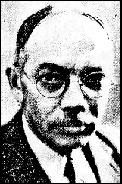 The coin (and stamp) column was written by Ralph Andrews Barry (1883-1939). He graduated from Princeton in 1906 with a degree in civil
engineering, worked for the New York Central Railroad from 1907 until 1914 and then joined the Jobson-Gifford Company of construction engineers,
where he rose to the position of chief engineer. As such he was involved in the construction of the BMT subway lines in New York City.
The coin (and stamp) column was written by Ralph Andrews Barry (1883-1939). He graduated from Princeton in 1906 with a degree in civil
engineering, worked for the New York Central Railroad from 1907 until 1914 and then joined the Jobson-Gifford Company of construction engineers,
where he rose to the position of chief engineer. As such he was involved in the construction of the BMT subway lines in New York City.
In 1933 he is said to have "retired" from Jobson-Gifford (more likely, he lost his job like so many others when the company failed during the Depression). Unable to find a new job when unemployed at age 50 he tried to turn his hobby, stamp collecting, into a new career. He was hyperactive at this, becoming the coin and stamp editor of the New York Herald Tribune and doing much to promote stamp collecting as a hobby, but it is doubtful that he ever made much money at this and may have been living by gradually selling off his assets.
This discouraging career path probably contributed to his early death, after an illness of six months, on December 10, 1939. He was a member of the New York Numismatic Club from 1935 to 1939 (which is why I know about him).
Journalists often keep personal scrapbooks of their own writings - the scrapbook may come from the Barry family. It would be worthwhile to check the American Numismatic Society archives to see if there is any correspondence that would shed light on this from either Ralph Barry himself or his widow, Claudine Jeanette Paff Barry.
Barry in the Princeton Alumni Weekly:
Princeton Alumni Weekly
American Philatelic Society Hall of Fame:
American Philatelic Society (http://stamps.org/HOF-1941#Barry)
Obituary in the Brooklyn Daily Eagle:
11 Dec 1939, Page 9 - at Newspapers.com
(http://bklyn.newspapers.com/image/52774618/)
To read the earlier E-Sylum article, see:
QUERY: WITH THE COIN COLLECTOR (www.coinbooks.org/esylum_v18n27a07.html)
THE BOOK BAZARRE
BOOK PREVIEW: LINCOLN'S METALLIC IMAGERY
KING IS COMING!
There is a new King in numismatics. Thanks to token and medal authority Paul Cunningham King is about to return. Of course, I am speaking of the standard work on Lincoln numismatics, published over a period of 20 years starting in 1924, compiled by Robert P. King.
The struck items bearing the portrait of Abraham Lincoln have been of collector interest since the first ones were issued, beginning with Lincoln's political campaign of 1860. Lincoln items remain of unabated collector interest to the present day.
King's compiled list has been of extreme use for token and medal collectors. But it has been of frustrating utility in cataloging Lincoln items. King’s descriptions were sparse. The few illustrations led to even greater exasperations. It was difficult to identify an entry in King that matched an item in hand. This was necessary to obtain a “King number,” of widespread use in the numismatic field.
Seven years ago a group of four numismatists took up the challenge to “redo King” to prepare a catalog which would honor our sixteenth president and provide a catalog with greater easy of use. (The book’s Introduction reveals prior attempts in listing Lincoln items.)
That group of four included Paul Cunningham. But one by one they dropped out of the project. Was the project that daunting? One group member was Fred Reed, while not displeased with the progress or narrowness of the numismatic cataloging project, he elected to prepare his own version of Lincolniana based on his own collection. The first volume, published in 2009, was so successful it led to a second 2012 volume, both including Lincoln items of all kinds and compositions.
Cunningham persevered. He obtained lists of Lincoln tokens and medals from collectors and public museums. But most important he gathered photographs. The new work had to overcome the shortcoming of King’s original listing.
I have been privileged to view the page proofs of Paul’s book. The new work is titled “Lincoln’s Metallic Imagery” perhaps influenced by Fred Reed’s use of “Image” in his first title.
The scope of Paul’s book. however, is limited only to metallic items, mostly die struck, a few cast pieces. The first impression is the wonderful illustrations, not necessarily exact size but what was missing in King – what every Lincoln collector longed for.
There are 37 chapters – each a separate topic. While this arrangement is an improvement over King’s scattered treatment – it seems he added new items at the end – without regard for any topical arrangement.
Paul’s catalog numbering system is satisfactory for numismatic use. Each item is assigned a number of its topical chapter, followed by a serial number. Serial numbers of later items in a chapter advance in increments, undoubtedly so new or undiscovered items can be added later in place.
In effect the catalog number designates the Type. Varieties, as different compositions, are assigned letter suffixes. This is somewhat of a universal token numbering system, long prorogated by token authority Russ Rulau in his token catalogs.
Of unsatisfactory concern, I observe, none of the items throughout the book are named, The author jumps right into the description following the catalog number. Oh, how I long for some of the familiar names some favorite items are called by.
Of extreme usefulness to be sure is the concordance at the end giving King numbers for Cunningham numbers in this book. Every one of King’s numbers has a corresponding Cunningham number. With the exception of 39 encased coins all 1210 of them are included! Otherwise Paul did not miss a one of King’s and added a thousand or more new ones.
The index is given in Excel format. While Excel is excellent in gathering and marshalling data it is difficult to read as text. I hate the boxes around every word or term.
In all, however, Paul Cunningham should be congratulated for his persistence in accomplishing a difficult task. Seven years was a long time to wait, but when I hold the book in hand I will exclaim “it was worth the wait!”
NUMISMATIC MISCELLANY: JULY 12, 2015
Quick Quiz: Philadelphia Landmarks on Coins
In honor of the Fourth of July, this newspaper article listed five Philadelphia-area landmarks that can be found on U.S. coins. How many
can you name?
To read the complete article, see:
Got change? 5 Philadelphia-area
landmarks that can be found on coins (www.nj.com/news/index.ssf/2015/07/got_change_5_philadelphia-area_landmarks_memoriali.html)
Will Texas Get Its Own Fort Knox?
And the solution would have to be even more complicated than Fort Knox - as Texas has promised that ordinary citizens will be allowed to store their own precious metal reserves there.
A spokesman for the Texas comptroller's officer, which is in charge of the gold plan, said: 'We are honestly at the phase where the questions we are answering are creating more questions that we have to answer'.
It has been suggested that private companies could pick up the cost instead, bidding to create a depository in exchange for charging storage and service fees.
The plan has kicked up chatter outside of Texas that it's a step toward secession, an idea raised now and then on the state's farthest political fringe. 'Just moving it would be pretty expensive and, unless Texas is anticipating withdrawing from the union, which I suspect is some peoples' want, I don't see what advantage it is...,' said Edwin Truman, a senior fellow at the Washington-based Peterson Institute for International Economics.
To read the complete article, see:
Will Texas get its own Fort Knox?
Lone Star State takes 5,600 solid gold bars out of Manhattan vault to 'keep them safe'... but doesn't have anywhere to put
them (www.dailymail.co.uk/news/article-3149395/Texas-wants-gold-inside-states-borders.html)
Numismatics of the Pink Panther
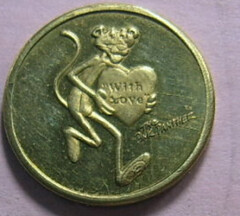
To read the complete article, see:
Sherlock Pink (1976) (fourthgarrideb.com/2015/07/sherlock-pink-1976/)
The Decline and Fall of Macedon
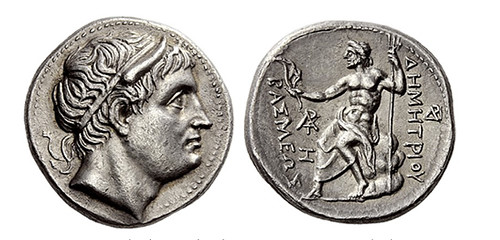
To read the complete article, see:
CoinWeek Ancient Coin Series – The
Decline and Fall of Macedon (www.coinweek.com/ancient-coins/coinweek-ancient-coin-series-decline-fall-macedon/)
International Congress of Electricians Medal
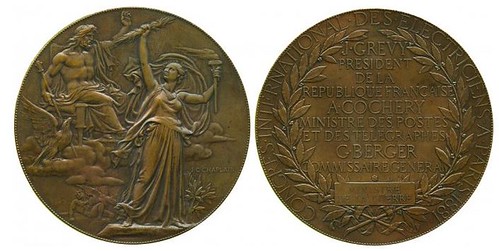
French “Art” Medals. Jules Clément Chaplain. International Congress of Electricians, Paris 1881, Copper Medal, by J C Chaplain, classical figure, Fame?, attending Zeus, below Prometheus, an eagle gorging on his liver, rev legend in wreath, 82mm (BDM I, 402). Extremely fine. From the Michael Hall Collection.
For more information, or to order, see:
International Congress of Electricians.
(www.baldwin.co.uk/international-congress-of-electricians.html)
Convict Love Tokens
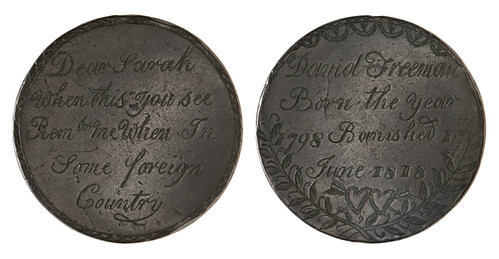
To read the complete article, see:
THE PARTING
GIFTS CONVICTS GAVE LOVED ONES BEFORE BEING SHIPPED TO AUSTRALIA
(www.atlasobscura.com/articles/the-parting-gifts-convicts-gave-loved-ones-before-being-shipped-to-australia)
World Police & Fire Games Challenge Coins
 Some in attendance at the World Police & Fire Games will be skipping ubiquitous T-shirts as a memento and opting for a commemorative
challenge coin.
Some in attendance at the World Police & Fire Games will be skipping ubiquitous T-shirts as a memento and opting for a commemorative
challenge coin.
Challenge coins feature a group’s insignia and motto. They’re frequently awarded to someone in the military or to first responders for outstanding service, but can also be given as mementos.
The Secretary of Defense recently gave challenge coins to wounded warriors participating in a 360-mile Ride To Recovery event which launched at the Vice President’s residence in D.C. and ended in Virginia Beach.
“It started with the military, but every sitting president since Bill Clinton has now had his own coin too. Although those are very hard to get. They’re presented for very special occasions,” says Kevin Touhy of Adrenaline Challenge Coins.
Touhy’s company started making the official challenge coin for the World Police & Fire Games in 2011 when the games were held in New York. It’s an honor Touhy is proud of as a former member of the U.S. Air Force and a retired firefighter. He served 34 years as a firefighter, 31 years in Orange County, California.
To read the complete article, see:
Challenge coins offered at World Police &
Fire Games (http://wtop.com/local/2015/07/challenge-coins-offered-world-police-fire-games/slide/1/)
A VISIT TO YALE’S COIN AND MEDAL COLLECTION
A Visit to Yale’s Coin and Medal Collection
Joseph Esposito
Each June for the past three years I have participated in the Yale Writers’ Conference in New Haven, Connecticut. This year I added a visit to the Yale Art Gallery, specifically the Coins and Medal Collection, and it turned out to be a memorable numismatic experience.
This collection, mostly seen by appointment, includes more than 120,000 coins, from colonial American to world specimens; thousands of paper notes; and a wide range of medals, tokens and store cards. One third of the coins are ancients. This is the largest coin collection at any American university.
There also are coins scattered throughout the museum as part of thematic displays, such as one on American silver, where a Massachusetts willow tree shilling accompanies other objects. Outside the numismatic rooms are display cases of coins and medals which highlight nature, architecture, women, Antoninus Pius and the House of Tudor.
At the entrance to the collection is a display case with twelve medals and coins representing some of the most important works of Bela Lyon Pratt (1867-1917), perhaps most noted for his design of the quarter and half eagle coins, examples of which are exhibited. Among the medals shown here are those for the Tavern Club of Boston, the New Theatre in New York and a large Yale Bicentennial Medal of 1901, one of a dozen of these in silver or bronze in this collection.
Pratt was a Yale graduate—as well as a protégé of Augustus Saint-Gaudens--and the coin center is identified as the Bela Lyon Pratt Study Room for Coins and Medals. A cast bronze plaque of Pratt by Richard Henry Recchia, a student of his, is outside the door.
The study room is actually two rooms, one which contains large vaults with trays of coins and space for viewing them and the other is a library and seminar room. Periodically, art, classics or economics classes meet here.
I e-mailed and made an appointment with Jane Miller, a senior museum assistant who works on the collection. She and John Stuart Gordon, an associate curator, were generous with their time, discussing the history of the collection and the range of the holdings; providing a select tour of the museum; and, most fascinating, allowing me to study a number of coins.
My interest was primarily in colonial coins, and my hosts assembled a sumptuous array in two large trays taken from the vaults. Each coin was housed in a handmade origami-type holder and, after cleaning my hands with a hand sanitizer, I was allowed to handle whichever ones I chose.
Now this is the incredible part: I was able to hold such treasures as a New England shilling; four of the five Libertas Americana medals—silver, gilt, copper and bronze cast (another silver is on display); and three Continental dollars—the Newman 1-C, 2-C and 3-D (here’s one example: http://artgallery.yale.edu/collections/objects/170936. There also was a 1793 bronze cent.
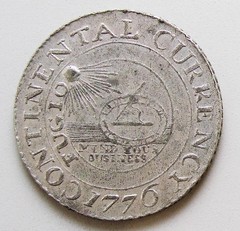
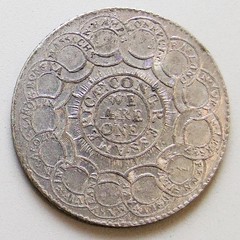
The colonial currency selection is impressive. I examined an uncut, double sheet with twenty-four, four-pence 1776 Pennsylvania notes from Hall and Sellers, which was spectacular. There also were two uncut sheets of Rhode Island notes. This was only a sampling. Among other highlights of the American collection is an extensive amount of Confederate currency, and colonial Connecticut coppers and medals bequeathed by C. Wyllys Betts, another Yale alumnus. Of course, Betts’s book on colonial medals, published posthumously in 1894, is a classic.
The world coin collection is also strong. It includes more than 3,000 pieces of German Notgeld money of the 1920s, ten trays of German medals, and various coins and medals from Europe and Asia. There also is a large holding in Chinese paper money.
The Yale Art Gallery has what is described as “the finest collection of early American silver in the world.” As such, coins form part of the gallery display of silver. Among these are the Montreal Peace Medal of 1760 and the previously mentioned willow tree shilling. A Carolina elephant token, a bronze, also is on display: http://artgallery.yale.edu/collections/objects/165110
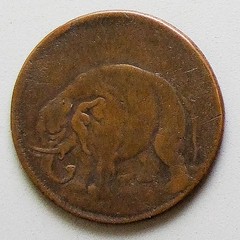
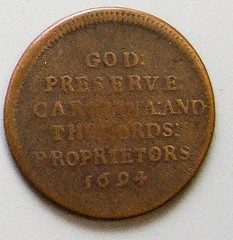
The collection, which moved from the nearby Sterling Memorial Library in 2001, has an interesting history. One bit of lore is that students long ago were able to check out coins from the library and study them in their rooms; they were on the honor system.
But on a less honorable side, the collection’s Brasher Doubloon was stolen by thieves in 1965. It was later recovered and auctioned by Stack’s for $650,000 in 1981. This is the Parmelee Specimen, one of seven Brasher Doubloons, and was last sold for $2.4 million in 2005.
Visits can be made to this fascinating, but perhaps lesser known numismatic treasure trove from Tuesday through Friday during normal business hours. The website provides additional information as well as excellent photos and descriptions of most of the coins in the collection.
For more information, see:
http://artgallery.yale.edu/coins-and-medals
GEORGE MINOT 1934 NOBEL PRIZE MEDAL OFFERED
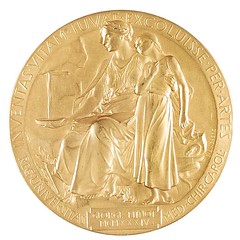 The Nobel Prize medal awarded to George Minot in 1934 for his pioneering work on the treatment of pernicious anaemia is to be sold at
Bonhams History of Science and Technology Sale in New York on September 21. It is estimated at $200,000-300,000.
The Nobel Prize medal awarded to George Minot in 1934 for his pioneering work on the treatment of pernicious anaemia is to be sold at
Bonhams History of Science and Technology Sale in New York on September 21. It is estimated at $200,000-300,000.
Minot (1885 – 1950) and his fellow scientists William. P. Murphy and George. H. Whipple won the Nobel Prize in Physiology and Medicine for their work in the study of anaemia. Minot and Whipple discovered that pernicious anaemia could be treated effectively with liver which is rich in vitamin B12. Further work confirmed B12 as a vital compound in the development of the treatment.
Minot came from a medical family. His father was a physician and one of his great-grandfathers, James Jackson, co-founded Massachusetts General Hospital. His home in Brookline, Massachusetts is designated a National Historic Landmark.
Bonhams Director of the History of Science, Cassandra Hatton, said: “Nobel Prize awards represent the summit of human endeavour and it always creates great excitement among collectors when a medal comes up for sale. George Minot’s work has saved and improved countless lives over many decades. It is interesting to note that Minot himself suffered from diabetes and had it not been for the discovery of insulin by earlier Nobel Prize winners in the 1920s he would almost certainly not have lived to make his own important contribution to the lives of others.”
The medal is being sold with the Nobel Diploma and other related materials.
To read the complete article, see:
Nobel Prize
medal of the man who cured anaemia to be sold at Bonhams
(http://artdaily.com/news/79743/Nobel-Prize-medal-of-the-man-who-cured-anaemia-to-be-sold-at-Bonhams#.VaGRSfm6dhE)

QUERY: WAS THE THREE HOURS FOR LUNCH CLUB MEDAL STRUCK?
 In early May, I was attending the annual meeting of the Grillparzer Club of the Hoboken Free State, a BSI scion organized by fellow
Garrideb Terry Hunt that honors Christopher Morley. During the course of the three hours that we were enjoying lunch, I was approached by the editor
of The Baker Street Journal, Steven Rothman, who showed me the lapel pin that he was wearing on his coat. Rothman commented that the design
was based on a medal for Morley’s Three Hours for Lunch Club, and asked if I had ever seen it. When I replied that I had not, he mentioned that they
had one of the medals in the archives at the University of Pennsylvania.
In early May, I was attending the annual meeting of the Grillparzer Club of the Hoboken Free State, a BSI scion organized by fellow
Garrideb Terry Hunt that honors Christopher Morley. During the course of the three hours that we were enjoying lunch, I was approached by the editor
of The Baker Street Journal, Steven Rothman, who showed me the lapel pin that he was wearing on his coat. Rothman commented that the design
was based on a medal for Morley’s Three Hours for Lunch Club, and asked if I had ever seen it. When I replied that I had not, he mentioned that they
had one of the medals in the archives at the University of Pennsylvania.
Later that same evening, I was lucky enough to have my train trip from New York’ to my home of Baltimore delayed by four hours. To pass the time, I started searching the internet to see if I could find any information on the medal that Rothman had mentioned. I came across the September 8, 1928 issue of The Saturday Review of Literature and on page 101 was Morley’s column, The Bowling Green. The column was titled Adventures In Hoboken and provided an update on the Three Hours For Lunch Club. In the middle of the page was a picture of a medal with the caption – “THE SUN’S OVER THE FORE-YARD, Symbolic medal designed by R. Tait McKenzie for the Three Hours for Lunch Club. The text of the column makes no reference to the pictured medal. The entire column can be read by clicking here.
Continuing to research this online, I discovered that the caption of the photo was slang used by naval officers to indicate that it was time for a drink.
I also came across the online inventory of the R. Tait McKenzie archive at the University of Pennsylvania and perused what was available in the 50 plus boxes of material available.
The following Saturday I was back in New York (no train issues this time!) to attend the Adventuresses of Sherlock Holmes Spring Luncheon. During the luncheon, I was seated next to Burt Wolder, one half of the team that produces the I Hear of Sherlock Everywhere podcasts. Wolder also makes the arrangements for his version of The Three Hours For Lunch Club to meet on the Thursday of BSI weekend in January the last several years. Wolder was also the person who had ordered the lapel pin that Steven Rothman had shown me the previous weekend. I mentioned that I was hoping to visit the Penn archives in the near future and Wolder mentioned that he would like to join the trip. So, on a sunny Friday in June, the two of us met up on the Penn campus.
We had made arrangements prior to our visit to pull three boxes from the archives that seemed the best fit for our research. Our first file produced multiple photographs of the medal. These photographs, to me, appear to be identical to the picture that appeared in the Saturday Review of Literature.
Next, we reviewed some of McKenzie’s correspondence with people whose last names started with “M.” We were hoping to possibly find some correspondence with Morley. No such luck.
The last item was a nearly four inch plaster galvano of the medal, pictured at the top of this post. Over the years, the plaster has endured a few nicks and chips to it. Holding the plaster in your hand, it really is a striking design
OBVERSE: (Tait’s monogram) / FECIT / 1926 / (a flag showing three hourglasses, on a foreyard and the sun rising behind it) / TRES HORAS NON / NUMERAMUS NISI / SERENAS
REVERSE: (blank)
99 mm, Round, Epoxy coated plaster, 12 mm thick
Now, for some speculation on my part…
I don’t believe that this medal actually exists. I believe that it only exists in this plaster format. That said, I hope to be proven wrong one day and an actual medal is found in copper, bronze, silver, gold or any other metal.
Greg is organizing a meeting for devotees of the numismatics of Sherlock Holmes at next month's convention of the American Numismatic Association in Chicago. Follow the blog or stay tuned here for more information. -Editor
To read the complete article, see:
Christopher Morley and The Three
Hours For Lunch Club Medal (http://fourthgarrideb.com/2015/07/christopher-morley-and-the-three-hours-for-lunch-club-medal/)
SCULPTOR AND MEDALLIST R. TAIT MCKENZIE
Who is Robert Tait McKenzie, the Canadian born sculptor who created the Three Hours For Lunch Club medal? Here is the biographical summary that the University of Pennsylvania has for him in the introduction to his archives there:
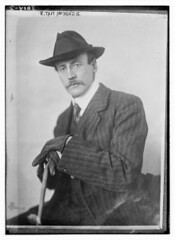 R. Tait McKenzie was born on May 26, 1867 to William McKenzie, a minister of the Free Church of Scotland, and Catherine Shiells McKenzie.
His father died while McKenzie was a young boy of nine years. McKenzie spent his youth in the town of his birth, Almonte, Ontario. At the age of
eighteen he entered McGill University and stayed nearly twenty years, as undergraduate, medical student, and after earning the M.D. degree in 1892,
as Medical Director of Physical Training and Lecturer in Anatomy. It was in his undergraduate years that his interests in physical education and art
first developed. James Naismith, inventor of the game of basketball, was a childhood friend of McKenzie’s, who attended McGill with him. It was
Naismith who kindled McKenzie’s interest in gymnastic activities later, at McGill, McKenzie assisted Naismith in teaching gymnastics at the
university. This not only gave McKenzie the opportunity to earn money to pay for his education, but served as the beginning of a career in physical
education which would last more than fifty years. It was also at McGill where he developed his theories on physical education.
R. Tait McKenzie was born on May 26, 1867 to William McKenzie, a minister of the Free Church of Scotland, and Catherine Shiells McKenzie.
His father died while McKenzie was a young boy of nine years. McKenzie spent his youth in the town of his birth, Almonte, Ontario. At the age of
eighteen he entered McGill University and stayed nearly twenty years, as undergraduate, medical student, and after earning the M.D. degree in 1892,
as Medical Director of Physical Training and Lecturer in Anatomy. It was in his undergraduate years that his interests in physical education and art
first developed. James Naismith, inventor of the game of basketball, was a childhood friend of McKenzie’s, who attended McGill with him. It was
Naismith who kindled McKenzie’s interest in gymnastic activities later, at McGill, McKenzie assisted Naismith in teaching gymnastics at the
university. This not only gave McKenzie the opportunity to earn money to pay for his education, but served as the beginning of a career in physical
education which would last more than fifty years. It was also at McGill where he developed his theories on physical education.
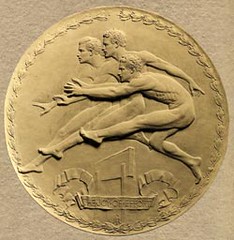 McKenzie believed that physical education and health activities had a beneficial relationship with the academic program in higher
education. He taught that a full understanding of that relationship helped the student preserve health and physical efficiency, learn certain muscle
skills, and to conduct himself as a gentleman in the social relationships of competitive games. McKenzie’s theme was that exercise kept human beings
well, serving as a preventative measure to illness. In 1904 he was appointed a full faculty member at the University of Pennsylvania. McKenzie was
attracted to Pennsylvania by the newly constructed gymnasium at Franklin Field, and viewed this as an opportunity to test his theory of physical
education as a vehicle of preventative medicine. He developed a physical education program which became part of the core curriculum at the
University. His book, Exercise in Education and Medicine, (Philadelphia: W.B. Saunders Company, 1909), set forth the evolution of physical
education in the United States and discussed exercise as a necessity for all individuals.
McKenzie believed that physical education and health activities had a beneficial relationship with the academic program in higher
education. He taught that a full understanding of that relationship helped the student preserve health and physical efficiency, learn certain muscle
skills, and to conduct himself as a gentleman in the social relationships of competitive games. McKenzie’s theme was that exercise kept human beings
well, serving as a preventative measure to illness. In 1904 he was appointed a full faculty member at the University of Pennsylvania. McKenzie was
attracted to Pennsylvania by the newly constructed gymnasium at Franklin Field, and viewed this as an opportunity to test his theory of physical
education as a vehicle of preventative medicine. He developed a physical education program which became part of the core curriculum at the
University. His book, Exercise in Education and Medicine, (Philadelphia: W.B. Saunders Company, 1909), set forth the evolution of physical
education in the United States and discussed exercise as a necessity for all individuals.
McKenzie’s first efforts at sculpture resulted from his inability to find sculptured pieces that demonstrated points in lectures on anatomy.
To read the complete article, see:
Who Is R. Tait McKenzie?
(http://fourthgarrideb.com/2015/07/who-is-r-tait-mckenzie/)
CANADA'S NEW POLAR MEDAL
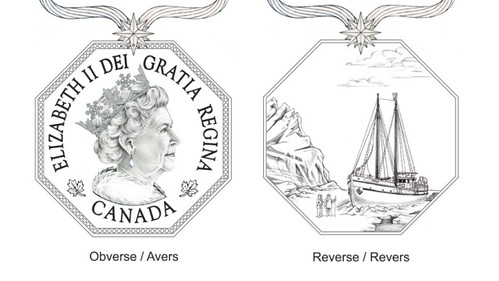
The Canadian government is replacing the Governor General's Northern Medal, which recognized people who made contributions to Northern identity and culture, with a new "Polar Medal" that will honour polar explorers and defenders of Canada's Northern sovereignty.
The Northern Medal was created in 2005 by former governor general Adrienne Clarkson and was awarded to "citizens whose actions and achievements contributed to the evolution and constant reaffirmation of the Canadian North as part of our national identity," according to the Rideau Hall website.
Nine people have been awarded the Northern Medal, eight of whom have been residents of N.W.T., Nunavut or Nunavik
In a news release, Governor General David Johnston said the creation of the Polar Medal "emphasizes the importance that our country places on strengthening our understanding of and connection to the North.
"Recognizing the outstanding contributions made by those working and living there, which is not without challenges and risks, will make our Canadian Honours System more comprehensive and better able to celebrate the full breadth of Canadian achievement."
Where the Northern Medal's design depicted a snowy owl and the aurora borealis and the medal was set in a crystal base, the Polar Medal will bear an image of the St. Roch, the RCMP ship that patrolled the Arctic in the early to mid-20th century, with a portrait of the Queen on the other side.
To read the complete article, see:
GG's Northern Medal replaced
by new Polar Medal (www.cbc.ca/news/canada/north/gg-s-northern-medal-replaced-by-new-polar-medal-1.3124454)
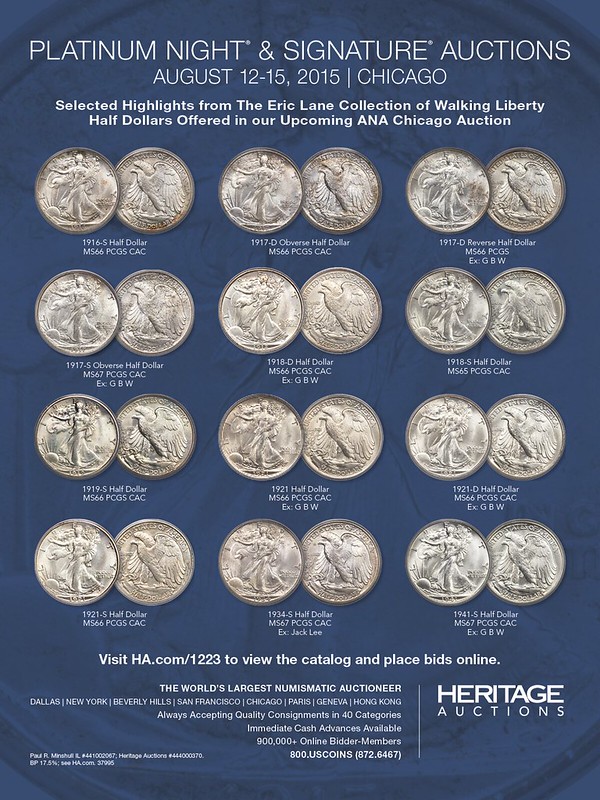
QUERY: BRAZILIAN 960 REIS HOST COIN IDENTIFICATION
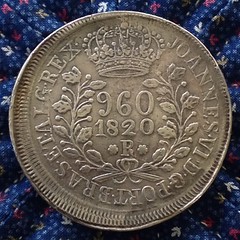
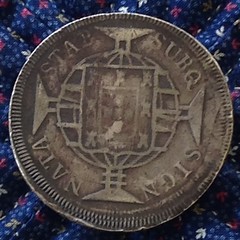
I need some help in identifying the host coin for an 1820R 960 Reis that I have. As you may know, most 960 Reis, Brazilian crown sized coins from the early 1800s, were struck over milled 8 Reales (or related coins) from Spain and the Spanish colonies in the Americas. A few were struck on virgin planchets. To my knowledge, none are known struck over hammered coins. About a year ago, I obtained an 1820R 960 Reis that appears to be struck over a hammered coin.
The coin at issue has a diameter of 43 mm (most 960s have diameters of 39 to 41 mm) and a weight of 25.5 grams (most 960s have weights close to 27 grams). The planchet is wavy and irregular and appears to me to belong to a hammered coin. The 960 was double struck, perhaps to completely cover the 43 mm, and so any details of obverse and reverse of the host coin have been obliterated. However, the original edge of the host coin is completely intact (perhaps the coin was too large to receive the "Brazilian" edge?) and has what appears to me to be Arabic script. If the host coin is an Islamic hammered coin, this 960 may be unique.



The diameter and weight of the coin seem to correspond fairly well to those of some Ottoman coins (2 kurus, 2 zolata, 2 piastres) of the late 1700s. I believe however that those coins were not hammered, and that they have plain edges. If anyone can offer some insight into what the host coin for this 960 Reis might be, I would greatly appreciate it.
U.S. MINT FILLS POSITIONS WITH FEMALES, VETERANS
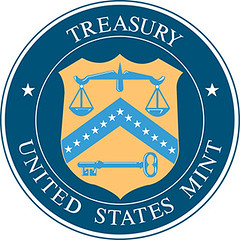 The
Mint’s circulating coin production levels over the past several months had increased dramatically due to an improved economy. The Mint was
receiving orders for circulating coins from the Federal Reserve (Fed) at levels approaching those not seen since before the recession in
2006. In fact, the orders were so significant that the Mint’s leadership realized that it needed to add another shift at its Denver and
Philadelphia facilities to meet the demand from the Fed. Both Denver and Philadelphia had been operating with two shifts.
The
Mint’s circulating coin production levels over the past several months had increased dramatically due to an improved economy. The Mint was
receiving orders for circulating coins from the Federal Reserve (Fed) at levels approaching those not seen since before the recession in
2006. In fact, the orders were so significant that the Mint’s leadership realized that it needed to add another shift at its Denver and
Philadelphia facilities to meet the demand from the Fed. Both Denver and Philadelphia had been operating with two shifts.
Going to three shifts, however, was going to require hiring additional people—quality, committed, disciplined and dedicated people. And what a better and more deserving force to offer employment opportunities to than our veterans? After all, the qualities the Mint was looking for are those that our veterans embody. So it was like a match made in heaven. Clearly, the Mint had a mission critical need to make coins in order to fulfill its orders from the Fed. Coins are an absolute necessity to sustain the economic fabric of our nation. At the same time, the partnership was providing some outstanding paths to sustainable careers to a very deserving cadre.
The Mint committed to holding two career fairs—one in Denver and the other in Philadelphia. Although open to the public, the fairs focused on veterans with a special outreach effort to women veterans. The positions that needed to be filled included metal forming machine operators; coin manufacturers; tool and parts attendants; and materials handlers.
The first career fair was conducted in late May in Philadelphia. Of the 41 people who attended, 20 were veterans. Seven were selected to be interviewed and all seven were offered positions. Four were women. In early June, the second fair was held in Denver where 42 individuals attended—38 of which were veterans. Nine veterans were interviewed and eight were offered positions. Seven of the eight were women. Prior to the career fairs, the Center for Women Veterans alerted VA’s Homeless Office to ensure that veterans who are homeless or at risk of being homeless were made aware of the events and able to participate.
We considered both career fairs extremely successful and couldn’t have been more pleased. The events said “thanks” to our veterans in a subtle but still very substantive way.
For more U.S. Mint information, see:
http://www.usmint.gov/pressroom/
RHETT JEPPSON NOMINATED FOR U.S. MINT DIRECTOR
Matthew Rhett Jeppson, Nominee for Director of the Mint, Department of the Treasury
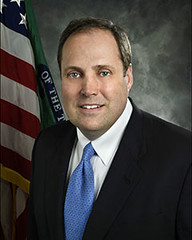 Matthew Rhett Jeppson is the Principal Deputy Director of the Mint, a position he has held since January 2015. Mr. Jeppson was Associate
Administrator in the Office of Veterans Business Development at the Small Business Administration (SBA) from 2012 to 2015 and also served as the
Acting Chief Operating Officer of SBA from 2014 to 2015. From 2010 to 2012, he was Lead Crisis Response Planner at U.S. European Command. Mr. Jeppson
served as Deputy Director of Operations for U.S. Forces Afghanistan from 2009 to 2010. From 2004 to 2008, he was Chief of Joint National Training
Capability and European Engagements Lead at the United States Special Operations Command and served as Counter-Terrorism Planner and Chief of Current
Operations for Marine Forces Europe from 2001 to 2003. Mr. Jeppson was Director of State Purchasing and Special Assistant to the Secretary at the
Department of Business and Professional Regulation of the State of Florida from 1999 to 2003, and he served as Operations and Exercise Officer at
Special Operations Command Central from 1995 to 1999. He was Vice President of E. Mark Jeppson, Inc. from 1992 to 1994. He also served as Principal
Battalion Staff Officer, 81mm Mortar Platoon Commander, Rifle Company Executive Officer, and Rifle Platoon Commander in the 1st Marine Division from
1989 to 1991. Mr. Jeppson received a B.A. from the University of Florida.
Matthew Rhett Jeppson is the Principal Deputy Director of the Mint, a position he has held since January 2015. Mr. Jeppson was Associate
Administrator in the Office of Veterans Business Development at the Small Business Administration (SBA) from 2012 to 2015 and also served as the
Acting Chief Operating Officer of SBA from 2014 to 2015. From 2010 to 2012, he was Lead Crisis Response Planner at U.S. European Command. Mr. Jeppson
served as Deputy Director of Operations for U.S. Forces Afghanistan from 2009 to 2010. From 2004 to 2008, he was Chief of Joint National Training
Capability and European Engagements Lead at the United States Special Operations Command and served as Counter-Terrorism Planner and Chief of Current
Operations for Marine Forces Europe from 2001 to 2003. Mr. Jeppson was Director of State Purchasing and Special Assistant to the Secretary at the
Department of Business and Professional Regulation of the State of Florida from 1999 to 2003, and he served as Operations and Exercise Officer at
Special Operations Command Central from 1995 to 1999. He was Vice President of E. Mark Jeppson, Inc. from 1992 to 1994. He also served as Principal
Battalion Staff Officer, 81mm Mortar Platoon Commander, Rifle Company Executive Officer, and Rifle Platoon Commander in the 1st Marine Division from
1989 to 1991. Mr. Jeppson received a B.A. from the University of Florida.
To read the complete press release, see:
President Obama
Announces More Key Administration Posts : Matthew Rhett Jeppson, Nominee for Director of the Mint, Department of the Treasury
(www.whitehouse.gov/the-press-office/2015/07/09/president-obama-announces-more-key-administration-posts)
To read the complete article, see:
Matthew Rhett Jeppson to be Nominated as
Mint Director (http://mintnewsblog.com/2015/07/matthew-rhett-jeppson-to-be-nominated-as-mint-director/)
NUMISMATICS IN THE PICTURE OF DORIAN GRAY
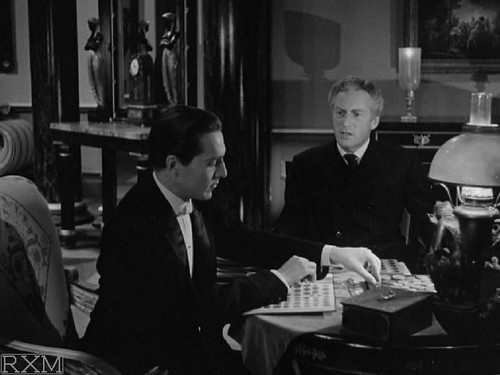
Dorian examines coins while Basil lectures him on his wicked life
Regarding Larry Dziubek's question about a coin collecting scene in The Picture of Dorian Gray, Ron Haller-Williams writes:
The director is strongly hinting that very soon Basil will see "both sides of the coin" in regard to Dorian!
Also it brings home visually that, although different, "art" and "culture." are likewise linked inextricably:
"According to Wilde, art is a good thing; it's purpose is to be purposeless, and the only thing it should be is beautiful. Culture, on the other hand, is not necessarily a good thing – it can be a bad influence. Dorian Gray examines the weird gray area (pun very much intended) between the beauty of art and the fascinating corruption of culture."
"He hides the painting in a storeroom and goes to look at occasionally. At one point Dorian is examining some large coins or medals and checking them against an illustrated coin catalog. The artist Hallward visits and lectures Dorian on his bad reputation. Dorian takes him to show him the painting and Basil is horrified. Dorian then murders Basil to silence him." Pictures 12, 13 and 14 of that page are relevant - plus 11 as Dorian brings out the box of coin trays.
The episode is covered in chapter XII, but I regard the coins as a device of the movie director, to show Dorian as blocking and distracting himself from Basil's lecture - maybe it is also the director's take on "Love of money is the root of all evil" (1 Timothy 6:10)
The sequence can be seen at (minutes:seconds) 62:50 to 65:20 of http://www.tudou.com/programs/view/c59m7ngY7-A
To read the complete article, see:
The Picture of Dorian Gray (1945)
(www.brianrxm.com/comdir/cnsmovie_picturedoriangray.htm)
To read the earlier E-Sylum article, see:
NOTES FROM E-SYLUM READERS: JUNE 28, 2015 : Numismatics in The Picture of Dorian
Gray? (www.coinbooks.org/esylum_v18n26a09.html)

OLD-TIME COLLECTORS AND THEIR OLD-TIME COLLECTIONS
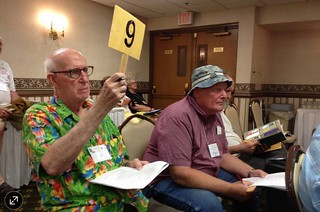 At a recent meeting of the Penn-Ohio Matchcover Club, Shirley Sayers had a confession.
At a recent meeting of the Penn-Ohio Matchcover Club, Shirley Sayers had a confession.
“We sat down one day and counted 36 things we collect,” said Ms. Sayers, a 67-year-old retired secretary. Along with about a million matchbooks, the collections include calendars, pens, straight razors and shoehorns.
“It’s nuts,” said Ms. Sayers. “Totally nuts.”
Many collectors of old stuff—things of mostly sentimental value, such as matchbooks, menus and postcards—worry that no one will want it all after they die. Meanwhile, they keep collecting more.
For younger people, collecting seems to be less of a priority. Online pursuits take up much of the time once given over to baseball cards or sea shells, and the hunt for that rare Beanie Baby is less interesting now that it can be found instantly on eBay, said Dr. Montana Miller, an associate professor of popular culture at Bowling Green State University.
In the Sayers’ home, figurines and other doodads still trump the virtual world. They crowd the living room and swamp the dining table. Two bedrooms upstairs are devoted to boxes and shopping bags bulging with matchbooks.
Museums often decline collections, though. The Smithsonian Institution museums “get offered way more than they can take,” said Linda St. Thomas, a spokeswoman. That doesn’t mean the Smithsonian won’t take a look. The institution’s National Museum of Natural History, for instance, has accepted several collections of ticks.
The Rathkamp Matchcover Society—a 75-year-old international group of matchbook collectors named for its late founder, Henry Rathkamp—has about 550 members, down from 1,600 in the 1980s. Many of the remaining members have grown old together.
Gregory Gibson, 65, a retired auto worker in Fenton, Mich., cherishes his collection of about 3,500 automotive license plates. Mr. Gibson doesn’t want to burden his wife with the collection if he dies first. So he intends to sell it within a few years. Even so, he still scours the Internet and browses antique shops. He hopes to find one of the few municipal plates issued by Valley City, N.D., around 1909 and made out of porcelain.
“Even though I know I’m going to be selling them, I’m still buying them,” Mr. Gibson said. “It makes no sense.”
To read the complete article, see:
What’s the Hardest Thing for Collectors to Find?
Someone Who Wants Their Stuff (www.wsj.com/articles/SB10377601820344704643704581052192921577246)
MILLENNIALS NIX THEIR PARENTS’ TREASURES
A seismic shift of stuff is underway in homes all over America.
Members of the generation that once embraced sex, drugs and rock-and-roll are trying to offload their place settings for 12, family photo albums and leather sectionals.
Their offspring don’t want them.
As baby boomers, born between 1946 and 1964, start cleaning out attics and basements, many are discovering that millennials, born between 1980 and 2000, are not so interested in the lifestyle trappings or nostalgic memorabilia they were so lovingly raised with.
Auction houses, consignment stores and thrift shops are flooded with merchandise, much of it made of brown wood. Downsizing experts and professional organizers are comforting parents whose children appear to have lost any sentimental attachment to their adorable baby shoes and family heirloom quilts.
Stephanie Kenyon, 60, the owner of Sloans & Kenyon Auctioneers and Appraisers in Chevy Chase, says the market is flooded with boomer rejects. “Hardly a day goes by that we don’t get calls from people who want to sell a big dining room set or bedroom suite because nobody in the family wants it. Millennials don’t want brown furniture, rocking chairs or silver-plated tea sets. Millennials don’t polish silver.” The formal furniture is often sold at bargain prices, or if it’s not in good shape, it might go straight to the dump.
“Baby boomers were collectors,” says Elizabeth Wainstein, 50, owner and president of Potomack Company Auctioneers in Alexandria, where lots of unwanted family treasures end up being sold. “They collected German porcelains or American pottery. It was a passion, and they spent their time on the thrill of the hunt.” She says younger people aren’t really that interested in filling shelves.
To read the complete article, see:
Stuff
it: Millennials nix their parents’ treasures
(www.washingtonpost.com/local/boomers-unwanted-inheritance/2015/03/27/0e75ff6e-45c4-11e4-b437-1a7368204804_story.html)
THE FUTURE OF THE NUMISMATIC HOBBY
Dave Bowers writes:
I have studied the coin market and its history for many years. All across the board, hobbies are changing. Kids do not build models anymore, crafts are a fraction of what they were 20 years ago, and I have no idea if there is a single shop in New Hampshire specializing in sports cards. In the early 1960s Chet Krause estimated there were 6,000 coin shops in the USA (every small town had one, large cities had a page of listings in the Yellow Pages), and so on.
Dave Lange writes:
I agree that collecting stuff (and hobbies in general) are on the decline, but that may change as the younger generation becomes more prosperous (assuming they do at some point). Young people are burdened with student loans and low paying jobs that keep them in small apartments well into their thirties. They aren't benefitting from the prosperity we knew as kids and young adults.
There does still exist some collecting interest in young people, but it may be of a more utilitarian nature. My ladyfriend's teenage boys actively collect Yu-Gi-Oh! cards, but then they actually play a game with them. The cards are prized and stored inside plastic sleeves, but they're not mounted in an album for display or submitted for grading.
Most of the new adherents to coin collecting in recent years have discovered this hobby as adults, oftentimes as a by-product of investing in bullion. I don't believe we'll ever again see coin collecting as the massive fad it became in the early 1960s, and the hobby may regain the smaller scale it had before the era of coin boards and folders. This is not a good sign for the large numbers of common coins that have survived, and it's doubtful that many persons will be just "filling the holes" with circulated Buffalos and Mercuries, but there should always be enough participants to support a market for choice and truly scarce coins.
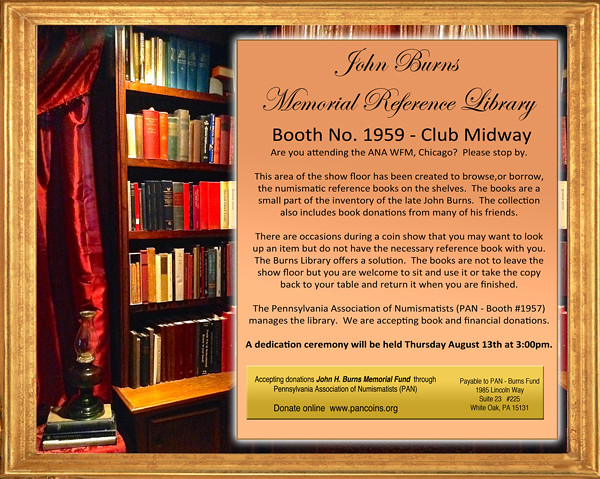
ROSENBLUM 2015 SUMMER AUCTION 45A HIGHLIGHTS

Lot 16: Thessaly. Skotussa. 480-450 BC. Silver Drachm
We've already given our mea culpa about the late date of the sale, the lack of photographs in the printed version of the catalog and the amount of lots in the auction. However no apology is needed for the quality of the material being offered. Among the ancient coins offered are a number of rare tiny coins of Samaria and Gaza and some rare and high grade coins from the Bar Kochba Revolt. High and/or rare coins from Gadara, Joppa, Skotussa, Mytilene, Alexandria are offered along with two different coins with what is believed to be the head of Cleopatra VII in a countermark. An exceptionally well-centered Judaea Capta denarius and coins from the collection of the well-known Washington DC numismatist Bill Porter round out this section.
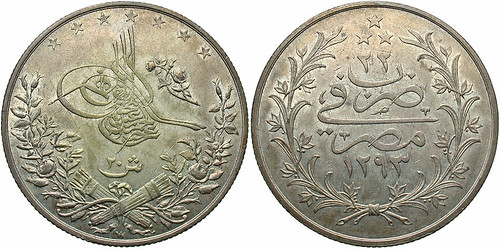
Lot 55: 1897 Egypt. Abdul Hamid II 20 Qirsh or Piastres
The world coin section is highlighted by the 2nd part of the Philadelphia Collection and high grade and rare coins of Egypt, Israel and Palestine are being offered. Included in these listings are three high grade 1948 25 Mil coins, the exceedingly rare 1960 Eight Grain Type I Agora, proof Pruta coins, error coins and some rare 21st century Israeli gold coins. From a different collection is an incredibly rare 1954 100 Pruta struck on an off- metal. Is it a pattern minted in Bern or an error minted in Tel Aviv? It's the first we've ever seen! The Palestine coins and tokens from this collection have numerous scarce and desirable pieces from five 19th century tokens, many key dates in high grade and a Proof single which is seldom avail- able.
Other highlights in the world coin section include some very rare and/or high grade African coins from Eritrea, Ethiopia, French Equatorial Africa, German East Africa, Guinea, Italian Somaliland and some remarkable pat- terns from Madagascar. In addition we offer eight rare and high late 18th and early 19th century coins of the Gold Coast as well as the exceedingly rare 1952 Proof set from Libya with a nice pedigree.
The world coin sections ends with a group of Lodz Ghetto tokens, a Swedish "Jehovah" 4 Mark silver coin US trade "box" dollar, and a long run of US merchant tokens. In addition to the "box" dollar there are 3 hand-engraved love tokens on 19th century silver crowns.
The World Paper section again is full of rare and seldom seen notes including a well-worn (and partially burnt) 1st issue Cyprus canteen chit from the Sylvia Haffner collection as well as the nicest 2nd issue set of 3 Cyprus Canteen notes we have ever seen. Other concentration camp and related highlights include notes from Buchenwald, Flossenburg, Nordhausen, Oranienburg, Sachsenhausen, Westerbork, Lodz and the Warsaw Ghetto.
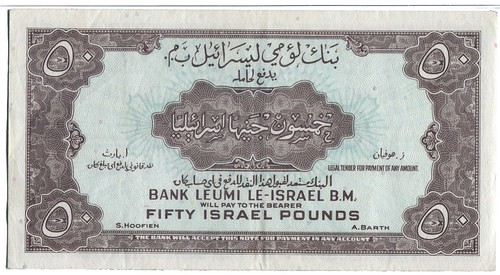
Lot 242: Israel, Bank Leumi 50 Pounds
The Israeli paper section has numerous rarities, specimens, trials and proofs. A few lots deserve special mention including a matched numbered set of 1948 carpet notes which we sold to "Mr. Philadelphia" nearly 30 years ago, a very high grade Neeman-Eshkol 100 Pruta Inverted signature error fractional note, a high grade and "slabbed" 50 Pound Bank Leumi note, a 1955 Bank of Israel Specimen set, a group of 23 different notes in a 1955 Bank of Israel Progress set of trial and proofs and a group of vignettes from the American Bank Note Company archives used on Israel Bonds in the early 1950s. In addition are 4 different Israeli errors as well a group of rare Six-Day War POW notes.
While the Palestine section doesn't have the block-busters of the last sale we do offer one of the very few known Palestine Currency Board errors which has a nice pedigree and is similar to the one in Rafael's Dabbah's book. We should know as we bought both of them at the same time more than 20 years ago. Also being offered are two high grade one pound notes, a nice 10 Pound note and 3 Anglo-Palestine Registered checks.
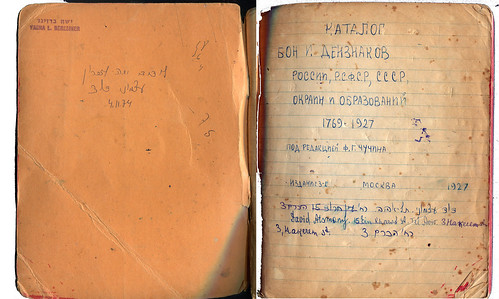
Lot 291: Handwritten Manuscript of David Atzmony's Russian Paper Money Catalog
The paper money section ends with the last of the large lots of Lodz Ghetto notes that we have been offering for the past few years, a run of chits and coupons from Lodz and the only book in the auction. It's the actual handwritten manuscript of David Atzmony's classic Russian Paper Money Catalog, This original piece of research is dedicated to one of the great paper money enthusiasts of all time, Yasha Beresiner, who was given the book by Atzmony in November of 1974 who signed it for Yasha.
Our medallic Judaica section as always has numerous rare and seldom seen items. Lot 294 is a silver "Feather Jew" medal by Christian Wermuth from the famed Arthur Polak collection and the first in silver we've offered in at least 35 years. Other highlights in this section include an 1782 Edict of Toleration Medal, a medal of Alberto Cohn, an 1878 Vercelli Synagogue medal, a hand-engraved 1904 (on a British 3 Pence?) silver Bar Mitzvah? love token, 2 Boris Schatz items, a 1937 Benno Elkan Marriage medal, an exceedingly rare gold medal issued by the Iranian Jewish Community in 1966 and numerous Holocaust related medals including a huge one of Raoul Wallenberg. Two unusual amulets are in this section, one which we believe the late Bill Spengler found in the mid-east, the other a large unidentified piece.
Our state of Israel medal section contains more than a handful of rare patterns, test strikes, trials, off-metal strikes or errors and unlisted items.
Our miscellaneous paper section is, as usual, a selection of various items that don't quite fit anywhere else. Included in this section are numerous different Kollel notes some offered individually and others in groups. Perhaps the highlight of the section is a hand-written letter, with the original envelope, from Henrietta Szold address to a prominent attorney in Pennsylvania.
The sale ends with a small listing of Holocaust related notgeld, some very rare anti-semitic propaganda overprints and other documents and memorabilia.
To view the complete online catalog, see:
http://rosenblumcoins.com/45a
THE COIN OF THE FUTURE
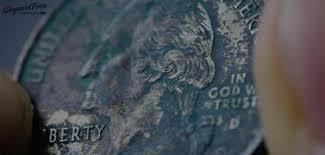
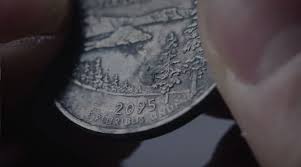
I have recently indulged in the somewhat entertaining serial television program 'Wayward Pines', and to my astonishment came a very brief but stunning sequence that some of you might find humorous.
Wayward Pines is a community in Idaho whose citizens were cryogenically frozen (most are unaware) for some 2000 years, then emerged from their sleep and have a relatively 'normal' existence, thinking it is real time 2015 when it is actually the year 4000-something. The town is walled off from the rest of the world which has devolved into a ruined environmental wasteland overrun by monster-like carnivorous human life forms.
In a short scene where the Wayward Pines school teacher is explaining 'the truth' to some newly 'unfrozen' students, she hands each student an 'ancient' coin, and urges them to look at the date. The coin images pop on the screen for perhaps a second or two, but reveal much.
OMG! It's a Quarter! OMG! It's a 2095 Quarter!
It can't be! But it is! A WASHINGTON QUARTER!!!
A State Quarter in fact! Oregon to be exact!
Yes friends, 80 years from now, apparently we will still be minting quarters, and they will still have the SAME obverse design as we have today, and we will be recycling dies of the state quarter program, and in the year 4000 ancient coin collectors will discuss mediocrity in coin design as it reflects ancient cultures.
For more information about the show, see:
www.fox.com/wayward-pines
READER RED BOOK RAMBLINGS
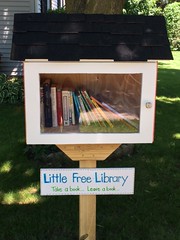 A brief one year follow-up on my Little Free Library (E-Sylum Vol. 17, No. 28, July 6, 2014):
A brief one year follow-up on my Little Free Library (E-Sylum Vol. 17, No. 28, July 6, 2014):
Hands down the most popular item that invariably goes within two days of its availability is the Red Book. I obtain outdated copies from a dealer friend and put them in the library regularly, I have distributed 32 of them in this first year since we built the Little Free Library. A testament to the universal popularity and usefulness of the Red Book.
On another note concerning the Leather Bound Limited Edition Red Books, I have to confess to feeling a smidgen disgruntled.
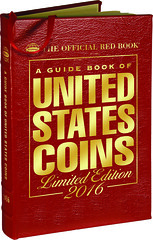 I have collected the Leather Red Books since their inception in 2005. I love the look, and feel, and of course the utility of the books,
and that they are signed by Ken and numbered. I believe the first issue was priced at $59.95 and the price gradually increased over the next ten
years until the 2014 edition was $79.95. However, in 2014 they never announced the publication of the 2015 edition and I wondered what was up, so I
called Whitman and was disappointed to learn the Leather bound books would be discontinued.
I have collected the Leather Red Books since their inception in 2005. I love the look, and feel, and of course the utility of the books,
and that they are signed by Ken and numbered. I believe the first issue was priced at $59.95 and the price gradually increased over the next ten
years until the 2014 edition was $79.95. However, in 2014 they never announced the publication of the 2015 edition and I wondered what was up, so I
called Whitman and was disappointed to learn the Leather bound books would be discontinued.
Then came the surprising announcement in the May 24, 2015 E-Sylum (Vol. 18, No. 21) that they were publishing the 2015 and 2016 volumes of the Leather edition simultaneously, at a print run of just 500 each, and at a price of $99.95 each. Wow! thank you for resuming the issue, but OUCH, now the collector has to expend $200 to get the '15 and '16 issues at the same time, and feels he has to do it quickly because of the low 'printage'.
Is this a formula for attempting to create a rarity? I don't know, but I am one collector who is out of the race. Stopping at ten issues isn't so bad. It's a nice round number and they still look great on my shelf.
 I found myself reading the Suzy B. (local Rochester gal) entry in the 2016 Red Book and puzzled over the claim:
I found myself reading the Suzy B. (local Rochester gal) entry in the 2016 Red Book and puzzled over the claim:
“First time that a woman other than a model or mythical figure has appeared on a circulating U.S. coin.”
Page 234 Susan B. Anthony Dollar -Par. two -
Of course Queen Isabella instantly comes to mind on the 1893 World’s Columbian Exposition Isabella Quarter. She was as real as could be, and that was, in fact, the era in which Ms. Anthony was so active on behalf of Women’s Rights.
I’d like Whitman to reconsider that entry, giving credit all around, for the women on our coins.
To read the earlier E-Sylum articles, see:
NOTES FROM E-SYLUM READERS: JULY 6, 2014 : Little Free Library
(www.coinbooks.org/esylum_v17n28a09.html)
NEW BOOKS: LEATHER-BOUND LIMITED EDITION RED BOOKS
(www.coinbooks.org/esylum_v18n21a05.html)

HAMMERED SILVER HALFPENNY OF EDWARD I FOUND
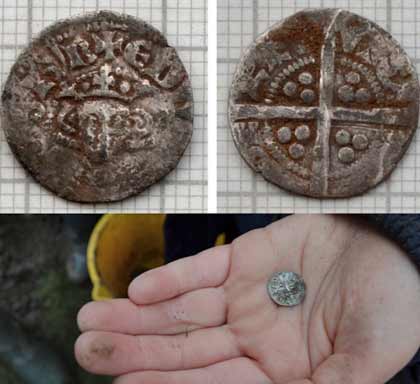
A hammered silver halfpenny coin, minted by Edward I after he came to power in 1272, has been discovered by a pair of nine-year-olds trowelling mud near the ruins of one of the most strategically important castles which chaged hands around the time the Anglo-Scottish Battle of Flodden two and a half centuries later.
Working in cold, wet morning conditions, two boys from the Scottish Borders found the coin under the guidance of organisers behind a £1.3 million project which will create an ecomuseum near the medieval Wark Castle in Northumberland.
“We found lots of medieval pottery, animal bones and, at the very end of the morning, the coin,” says Jane Miller, an Education Officer for the Flodden 1513 museum, whose experts have helped eager children and volunteers investigate an area briefly captured by James IV’s Scottish army in 1513.
“This exciting find was the icing on the cake.”
The first king to mint halfpennies, Edward I was born in 1239 and became known as Longshanks because of his height. He was also called the Hammer of the Scots due to his involvement in the Scottish succession, when he decided the competing claims of John Balliol and Robert Bruce to the Scottish Crown.
Flodden was the last medieval battle fought on British soil, when a Scottish force of at least 30,000 men, led by King James IV, encountered a smaller English force assembled by the Earl of Surrey on behalf of King Henry VIII.
To read the complete article, see:
Archaeologists find King's hammered coin at site of Anglo-Scottish conflict which was last medieval battle on British soil
(www.culture24.org.uk/history-and-heritage/archaeology/art528492-archaeologists-find-king-hammered-coin-at-site-of-anglo-scottish-conflict-which-was-last-medieval-battle-on-british-soil)
MORE ON THE BRISTOL OLD VIC 'GOLDEN TICKET' TOKEN
Jorge Proctor writes:
Reading the article about the "golden ticket", you wrote: "Unfortunately, the article does not picture the token. Would anyone have an image, or know where to get one?". Well, ask and you shall receive. Please find below a link to where there is an image of the "golden ticket" (notice that this is from the University of Bristol, where the token was donated).
Also, on another note, notice that the difference between this token, and what one of the other 50 issued looks like, is that the other 50 were individually numbered, where as this one says (and most likely also the other missing token), only "No." appears for the number, with no number of issue, and then the other 50 also say "The Proprietor", where as the "golden tickets" were issued with "The Bearer."
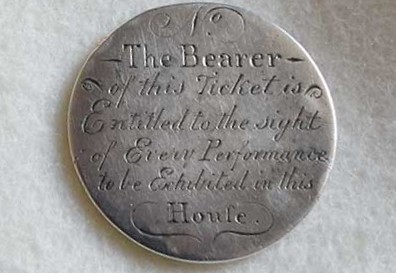
The ‘gold’ ticket (one of only two issued) is actually made of silver and is very similar to the 50 silver tickets except it has the word ‘Bearer’ rather than ‘Proprietor’ on it and is not numbered.
The tickets donated by Mrs Menez are accompanied by histories of their previous ownership, such as a bill of sale for one silver ticket at a cost of £20 dated 20 September 1855, and also include one of only two 'gold' versions ever issued. They will join the five silver tickets already held by the Theatre Collection, which is also home to the Bristol Old Vic Archive.
Fifty of the ‘tickets’ were originally awarded in the 1760s to the fifty proprietors who each pledged £50 towards the cost of building a new theatre in King Street. This was at a time when a low paid domestic servant earned £2 a year and an entire family household could be run on £40 per year.
The tickets took the form of a silver token, numbered between 1 and 50, which entitled the proprietor “to the sight of every performance to be exhibited in this house” – a promise the theatre honours to this day.
In 1766, two so-called ‘gold’ bearer tickets were also issued to Edward Crump, a cabinet maker, and his wife Ann. The Crumps were not shareholders, but were given the special bearer tickets for “the great trouble and expense” that Crump had gone to in order to persuade others to make over the land on which the theatre was built. The whereabouts of these ‘gold’ tickets (which are actually made of silver and very similar to the 50 shareholder tickets) has been unknown – until now.
Mrs Menez also donated the hand-drawn plans for the re-modelling of the frontage of the theatre in 1902, carried out by her great-grandfather, the builder, Henry Forse. These plans provide important information about parts of the theatre that were demolished in the 1970s. Forse was passionate about the theatre and it was he who collected the four tickets and other historic documentation and handed it down through his family.
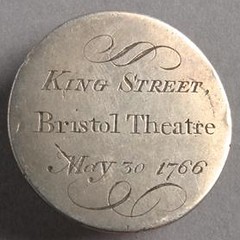
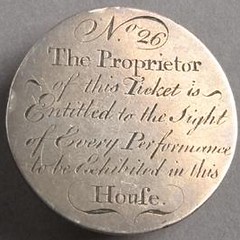
One of the other 50 normal tokens (this one is number 26):
To read the complete article, see:
Old Vic silver tickets come home to Bristo
(www.bristol.ac.uk/news/2015/june/old-vic-silver-tickets.html)
For images of the normal tickets, see:
Theatre token (front)
(http://discoveringbristol.org.uk/browse/slavery/theatre-token-front)
Theatre token (back)
(http://discoveringbristol.org.uk/browse/slavery/theatre-token-back)
To read the earlier E-Sylum article, see:
'GOLDEN TICKET' TOKEN STILL GOOD AFTER 250 YEARS
(www.coinbooks.org/esylum_v18n27a12.html)
To read the complete article, see:
250-year-old Bristol Old
Vic "golden ticket" found
(www.bristolpost.co.uk/250-year-old-Bristol-Old-Vic-golden-ticket/story-26798905-detail/story.html)
Jorge writes:
I found a news report from 2008 where the theatre was undergoing a refurbishment and following the fundraisers of 1766 another fifty silver tokens were issued by the theatre with the 1766 design, so these could be given to those donating £50,000 or more. . The new tokens were to be numbered from 51 to 100.
To read the complete article, see:
Bristol Theatre Tokens
(www.tokenpublishing.com/news.asp?gid=13&nid=436)
To read the complete article, see:
BRISTOL OLD VIC RECOGNISES
MERCHANTS’ GIFT WITH HISTORIC SILVER TOKEN
(http://merchantventurers.com/bristol-old-vic-recognises-merchants-gift-with-historic-silver-token/)
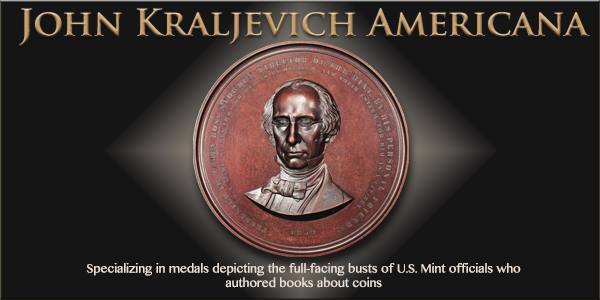
HOW MANY FACES OF WOMEN ARE THERE ON BANKNOTES?
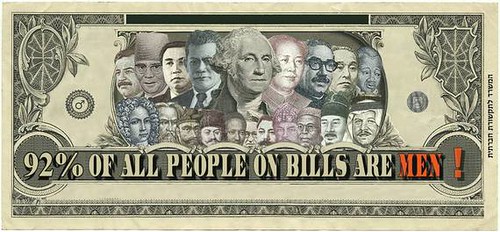
Based on a research* that I recently conducted on all hundreds of bills used in all 195 countries around the world, there are 609 people who were chosen to appear on a bill, from which only 51 of them are women, approximately only 8 percent.
Meaning:
Ninety two percent of the people appearing on the bills from around the world are men.
And this is only an average, not the extreme. In many countries bills are 100 percent "male." In Cuba for example, you can find no less than 11 different testosterone makers, but not even a drop of estrogen. Guatemala and Croatia also maintained a zero representation of women, but used 10 suits for each country. You can also find zero point zero women representation in Albania, Poland, Singapore, Thailand, Armenia, Barbados, China, Hungry, Indonesia, India, Jordan, Mauritius and more. New records were broken by Ghana, who doesn't use a man on each bill, but six!
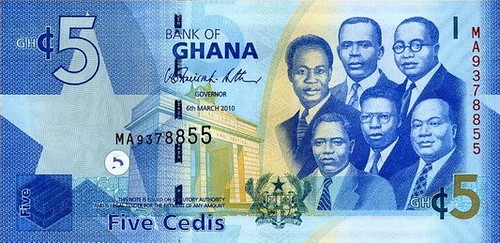
* The research was done through online databases, and there might be simple updating issues and a slight deviation in the results.
To read the complete article, see:
So,
How Many Faces of Women Are There on Banknotes Around the World?
(www.huffingtonpost.com/shir-nosatzki/only-8-percent-of-the-faces-on-banknotes-around-the-world-belong-to-women_b_7737254.html)
TREASURY STANDS BY PLAN TO REPLACE HAMILTON PORTRAIT
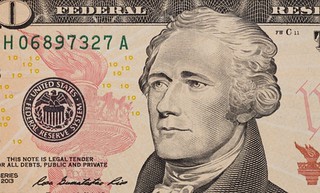 Treasury Secretary Jacob Lew is sticking with his plan to replace Alexander Hamilton on the $10 bill with a woman.
Treasury Secretary Jacob Lew is sticking with his plan to replace Alexander Hamilton on the $10 bill with a woman.
Lew announced last month that as part of a redesign of the $10 note, he hoped to put a woman on the bill. The department called for the public to weigh in on who should be honored. He said he expects a final decision soon.
"I think we have waited long enough," Lew said of the move to put a woman on U.S. paper currency for the first time in 100 years. He made his remarks Wednesday during an appearance at the Brookings Institution.
The initial announcement to remove Hamilton triggered a public outcry.
Critics of the decision complained that Hamilton, the nation's first Treasury secretary, should be left on the $10 bill. Instead, they argued, a woman should be featured on the $20 bill in place of Andrew Jackson, who many historians view less favorably because of his treatment of Native Americans.
Former Federal Reserve Chairman Ben Bernanke wrote in a blog post that he was "appalled" by Lew's plans to replace Hamilton, calling him "without doubt the best and most foresighted economic policymaker in U.S. history."
Asked about all the controversy, Lew said that he wanted to move quickly to honor a woman and that the next bill scheduled for redesign to improve anti-counterfeiting features is the $10 bill.
Lew said that Hamilton's image would be retained in some way on the redesigned bill. But his position has drawn fire from Democratic presidential candidate Hillary Rodham Clinton, who said a woman should not have to share the $10 bill with a man.
Treasury has said that once a woman is selected, it will aim to complete the redesign by 2020, the 100th anniversary of the passage of the 19th amendment giving women the right to vote.
To read the complete article, see:
Lew Sticking With Plan to Put Woman on
$10 Bill (www.nytimes.com/aponline/2015/07/08/us/politics/ap-us-currency-redesign.html?_r=0)
To read the earlier E-Sylum article, see:
THE 'KEEP HAMILTON' MOVEMENT GAINS STEAM
(www.coinbooks.org/esylum_v18n26a22.html)
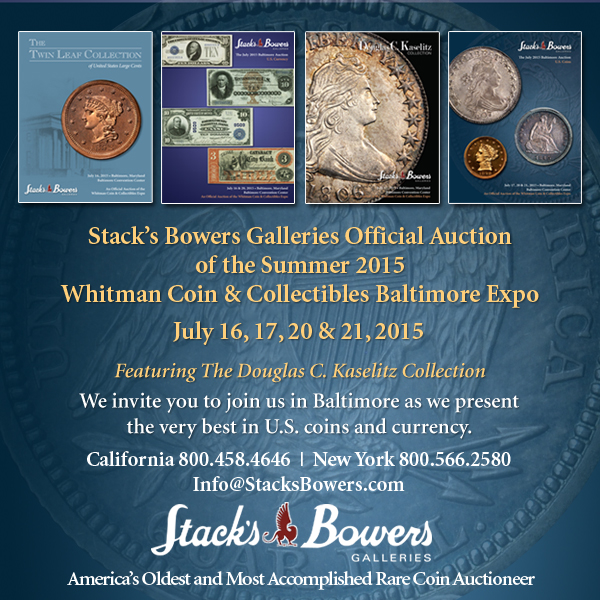
NEW SYRIAN BANKNOTE DROPS ASSAD PORTRAIT
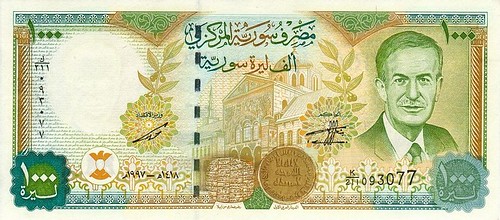
The Central Bank of Syria began circulating the country’s new 1,000-pound note, and one major question is being left unanswered in English media reports — why the currency was redesigned without a face from the Assad family.
The old 1,000-pound note featured former president Hafez al-Assad, father of President Bashar al-Assad. In 2013 the Central Bank made the decision to replace it with an image of an ancient Roman theater located in the southern Daraa province, the birthplace of the revolution.
The new photo of the Bosra Amphitheater in Salkhad, only 40 kilometers east of Daraa city, now adorns the face of one of Syria’s most commonly used bills. The decision left government supporters outraged, causing some social media users to change their Facebook profiles to the old bill with Hafez’s face on it.
According to the Central Bank, the old note with Hafez Assad needed better paper quality and security features. In a press conference Tuesday, Central Bank Governor Adib Mayalah elaborated and added that printing new notes shows the Syrian economy is capable of overcoming the difficulties it's facing, especially given the American and European sanctions on Syrian currency.
But the statement failed to give a reason it would require a new image on the face of the bills, or why — of all the Syrian landmarks to use — they chose a Roman theater in the province where the uprising began.
Jeffry Frieden, international monetary and financial relations professor at Harvard University, told Al Bawaba he couldn’t think of a security reason to change the image.
"Whether it was done as a snub to Assad, or as something of a sop to the opposition, ... I have no idea,” Frieden wrote. “But I cannot see a legitimate security-based argument, so it would be interesting to try to figure out what is actually going on."
Turns out, there’s a more likely explanation than what’s being offered by officials.
The Syrian note has been subject of a smear campaign by the opposition in which they write offensive words — “Curse your soul, Hafez” — about the former leader by his image. The slogan was chanted by demonstrators at the start of the revolution.
Not only was the trend embarrassing to the government, it also presented a legal challenge for authorities. Possessing the paper notes with the insult could lead to one’s arrest, according to Arabic news al-Khaleej Online, leaving residents more reluctant to use them. Opposition claims the campaign is what pushed the regime to change the image.
It’s hard to say how successful the campaign was. A resident in Syria’s capital Damascus had never seen offensive words being written on a bill but believed Syrians would be in big trouble — arrested, possibly beaten — if they were caught with one. It’s likely the campaign took off in areas no longer being controlled by the government.
Regardless, the decision seems to be a big one that couldn’t have happened without the approval of Hafez Assad’s own son, Bashar.
To read the complete article, see:
Why was a face of the Assad family
just removed from Syrian currency? (www.albawaba.com/news/why-was-face-assad-family-just-removed-syrian-currency-717212)
UPSIDE-DOWN MAO WATERMARK ERROR BANKNOTE

A businessman in Wuhu who came in possession of a misprinted 100-yuan bill was shocked to find out recently that it might be worth millions.
The rare bank note, dated 1999, features a watermark image of Chairman Mao that was mistakenly printed upside-down.
The man said he came across the bill as he was standing in line at a bank eight years ago. He'd seen another elderly customer holding it, and upon noticing the inverted image of Mao, asked if he could trade him for another 100-yuan note, because his brother-in-law "thought it was funny".
Last month, he posted a picture of the bill online and began receiving offers from collectors, some who were willing to pay over 70,0000 yuan to get their hands on defected bank note. A Shanghai auction house told him the note worth 23 million yuan.
A local bank verified the bank note's authenticity after running it through a counterfeit machine, Hong Kong Free Press reports, citing Anhui news. The chances of money being misprinted are a million to one, and such bank notes are typically pulled out of circulation by banks.
The Chongqing owner of a flawed 100-yuan banknote which featured a tiny line misprinted on Mao's chin was previously offered up to 1.5 million yuan for the thing.
To read the complete article, see:
Flawed banknote featuring upside-down Mao worth up to 23
million (http://shanghaiist.com/2015/07/09/flawed-banknote-upside-down-mao.php)
To read the earlier E-Sylum article, see:
MAO CHIN MARK MAKES A VALUABLE ERROR BANKNOTE
(www.coinbooks.org/esylum_v18n23a30.html)
HARVEY STACK ON THE PRINTED WORD IN NUMISMATICS
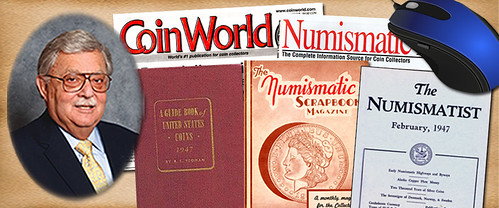
David Harper, editor of Numismatic News, was the guest speaker at the Texas Numismatic Association Show in early June. He spoke on many subjects, and one in particular was food for thought for me. He discussed changes he foresaw that might lead to the demise of the printed word in numismatics. This caused me to sit down and reminisce about my close to 70 years as a professional numismatist and how the hobby’s sources of information have changed during the last decades.
When I first joined Stack's in the 1940s numismatic Information was sparse. The publications available were issued monthly, some semi-annually and others yearly. News about what was happening in the marketplace came slowly and could be difficult to locate. The Guidebook and the Standard Catalog were issued yearly, The Numismatist (ANA), Numismatic Scrapbook, and some society publications were issued monthly and /or semi-annually. The Coin Collector Journal was issued sporadically. Occasionally references were written or re-written. Stack's tried a quarterly publication but after two years we gave it up, as it did not seem to reach mainstream collectors.
One major source of current markets and prices at the time was the public auction and mail bid auction catalogs issued by different dealers about the country. With the exception of Stack’s monthly sales, these were not always issued on a regular basis. The prices realized published by the auctioneers after the sales were also an important source of market information.
In the early 1960s Amos Press, decided to publish a weekly newspaper called Coin World. Under the editorship of Margo Russell and later Beth Deisher this publication provided much additional needed information as to the growth of the coin market.
While the Guide Book continued to provide annual information on coins and pricing, ads in Numismatic News and Coin World (as well as in monthly publications), together with dealer price lists and auction prices realized, became important market information sources throughout the year.
In his comments at the Texas Numismatic Association Show, David Harper predicted that within the next 25 years the need for these printed publications would be almost non-existent. It made me wonder if in the future, all coin and market information, current and historic, will need to be retrieved (if one knows how and where to look) using the electronic devices we all seem to have or will obtain.
As the hobby grew in the years from about 1980 to the present, the quantity of printed numismatic material grew. As more people became interested in coin collecting several new publications became available such as Coins Magazine, the Coin Dealer Newsletter, and many more. More dealers entered the field and more pricelists became available for reference. Also, there were more public auctions and therefore more prices realized were available. Information came from the newly formed grading companies in the form of population reports.
The next big change, of course, was the advent of the Internet. As early as the 1990s, the shift began toward online marketing and sales, as well as the spread of information via electronic media. Over the next two decades this trend only increased and even the popular weekly publications started to lose circulation. With so much information available on the Internet, fewer people felt the need to hold a printed publication in their hands.
Coin sales, once done mostly in person or by mail or phone, became “easier” over the Internet. Buying and selling could be accomplished instantly, and even payment could be happen immediately. Public auctions were affected, as many auction houses put their sales online as well as in printed catalogs. Bidding by mail became much less popular as collectors could bid directly online, without relying on the postal service. This process was much faster and the Internet offered the ability to track and increase bids without even the “inconvenience” of a phone call. In time, bidding in “real time” over the Internet changed the public auction scene completely, as personal attendance became less important as one could even watch and listen to the auction while bidding from home.
Circulation for coin publications dropped, as people searched for the information they needed online. Advertising in the weekly and monthly publications started to drop along the circulation numbers and some publications went out of business. Those publications that survived have needed to adapt to the current situation and offer online publications to meet the needs of a new generation.
Business became dependent on electronics and each company had to figure out how to use the Internet effectively while still appealing to clients who relied on printed material. At this point, the hobby seems to be straddling both worlds. But as we move forward, I can see why David Harper predicted that his publications and others might not exist by the year 2040.
I have some opinions on the effect the Internet has had on our hobby. Having been in the business for well over half a century, I believe my observations may have some value. While the Internet has been very beneficial in many ways, I can’t help but think of some ways that it has changed numismatics in not so positive ways.
Next week I will talk a little about why I hope we are not seeing the end of the “print culture” in coin collecting.
To read the complete articles, see:
The Demise of the Printed Word in Numismatics, Part One (www.stacksbowers.com/NewsMedia/Blogs/TabId/780/ArtMID/
2678/ArticleID/65216/The-Demise-of-the-Printed
-Word-in-Numismatics-Part-One.aspx)
The
Demise of the Printed Word in Numismatics (www.stacksbowers.com/NewsMedia/Blogs/TabId/780/ArtMID/
2678/ArticleID/65233/The-Demise-of-the-Printed-Word
-in-Numismatics.aspx)
CASE STUDY: NUMISMATIC LITERATURE IN THE HUMANITIES
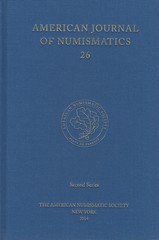 The article is from the recently published American Journal of Numismatics (vol. 26). The author makes some interesting points:
The article is from the recently published American Journal of Numismatics (vol. 26). The author makes some interesting points:
The coverage of numismatics in the most popular citations indexes (Scopus, Web of Science, ERIH) is very low. These search engines are periodical-focused whereas numismatics has many sources outside periodicals (exhibition and auction catalogs, books, conference proceedings). The author estimates the coverage at 2%.
Self-citation in numismatic journals is very high – not necessarily good or bad by itself (although self-citation is sometimes associated with “gaming” the system in order to boost search results), but demonstrates a degree of “self-sufficiency” that may highlight a need for more inter-disciplinary approaches.
The age of quoted literature in numismatics is much higher on average than in the humanities. The author is not especially alarmed and points to the static nature of old auction catalogs, a large corpus of important 19th century literature, and the International Survey of Numismatic Research, which is published only once every six years.
THE BOOK BAZARRE
FEATURED WEB PAGE: COINS IN MOVIES
This week's Featured Web Page is Coins in Movies from BrianRxm Website. It also has a Coins in Television page.www.brianrxm.com/comdir/cnsmovie.htm
